Browns Shoes Expands Across Canada
Exploring the retailers impressive growth and continued success. pg. 14

Browns Shoes Expands Across Canada
Exploring the retailers impressive growth and continued success. pg. 14

Edo Japan’s Proud Canadian Vision
Company’s Calgary roots helping it to expand across Canada and into the US. pg. 20
Bringing Paper Bags Back to Retail
Gather Packaging reshaping the Canadian retail packaging industry. pg. 26






✅ Develop talent

✅ Scale efficiently

✅ Streamline store operations



“There is a clear correlation between Progress Retail and the positive impact on our store sales and operational metrics.”
Justin Asgarpour Chief Vision Officer

















As we enjoy the summer of 2025, one theme continues to define Canadian retail: pride. Not just pride in where we shop, but pride in the brands, people, and stories that make this industry thrive.
This issue of Retail Insider the magazine shines a light on that pride. From Browns Shoes’ remarkable evolution under fourth-generation leadership to Edo Japan’s continued expansion rooted in Calgary values, we explore what it means to grow while staying true to Canadian identity.
You’ll also read about Gather Packaging, a company bringing paper bag manufacturing back home -- a move that underscores the importance of local production and sustainability.
An article explores the decline of Canadian department stores, highlighting factors like shifting consumer habits, e-commerce growth, and economic challenges. Once-dominant retailers struggle to adapt, leading to closures, job losses, and the transformation of retail spaces across Canada’s urban landscape.
An article examines the challenges Canadian businesses face due to U.S. tariffs, including increased costs, disrupted supply chains, and reduced competitiveness. Many firms struggle to adapt, prompting calls for government support and strategies to diversify trade beyond the U.S. market.

Canadian retail faces challenges, from inflationary pressures to global uncertainty, yet innovation and adaptability remain at the forefront. Businesses across the country are leaning into technology, strengthening supply chains, and doubling down on the customer experience. These strategies will define the next chapter of success for retailers from coast to coast.
Thank you to our readers, contributors, and partners who continue to support and inspire us. Your commitment ensures that Canadian retail remains vibrant, resilient, and globally competitive.
Enjoy the issue, and here’s to celebrating Canadian pride -- today and always.
Sincerely,

Craig Patterson Publisher craig@retail-insider.com

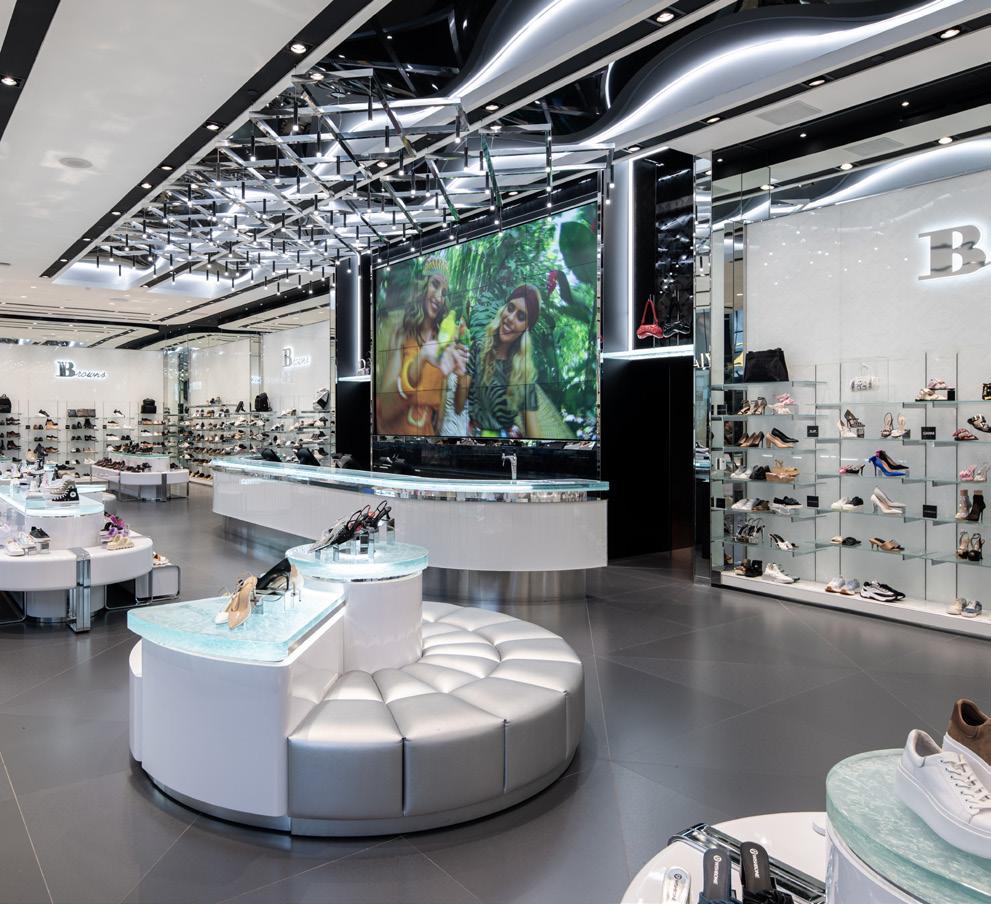
14 // Browns Shoes Expands Across Canada Under Fourth-Generation Leadership
Brown’s shoes President David Brownstein shares insights concerning the retailers impressive growth, digital investments, and family-drivenculture that’s helped it sustain success throughout the years.
20 // Edo Japan: Calgary Born QSR Brand Expands with Canada Proud Vision
In a landscape filled with fast food options, one proudly Canadian brand has not only endured but grown by staying true to its roots. Edo Japan, the Japanese-inspired quick-service restaurant chain founded in Calgary, is quietly transforming the Canadian QSR industry.
26 // Gather Packaging Brings Paper Bag Manufacturing Back to Canada
In a move that seems set to completely transform the retail packaging industry in Canada, Gather Packaging has officially launched as a new domestic manufacturer of premium, sustainable paper shopping bags.
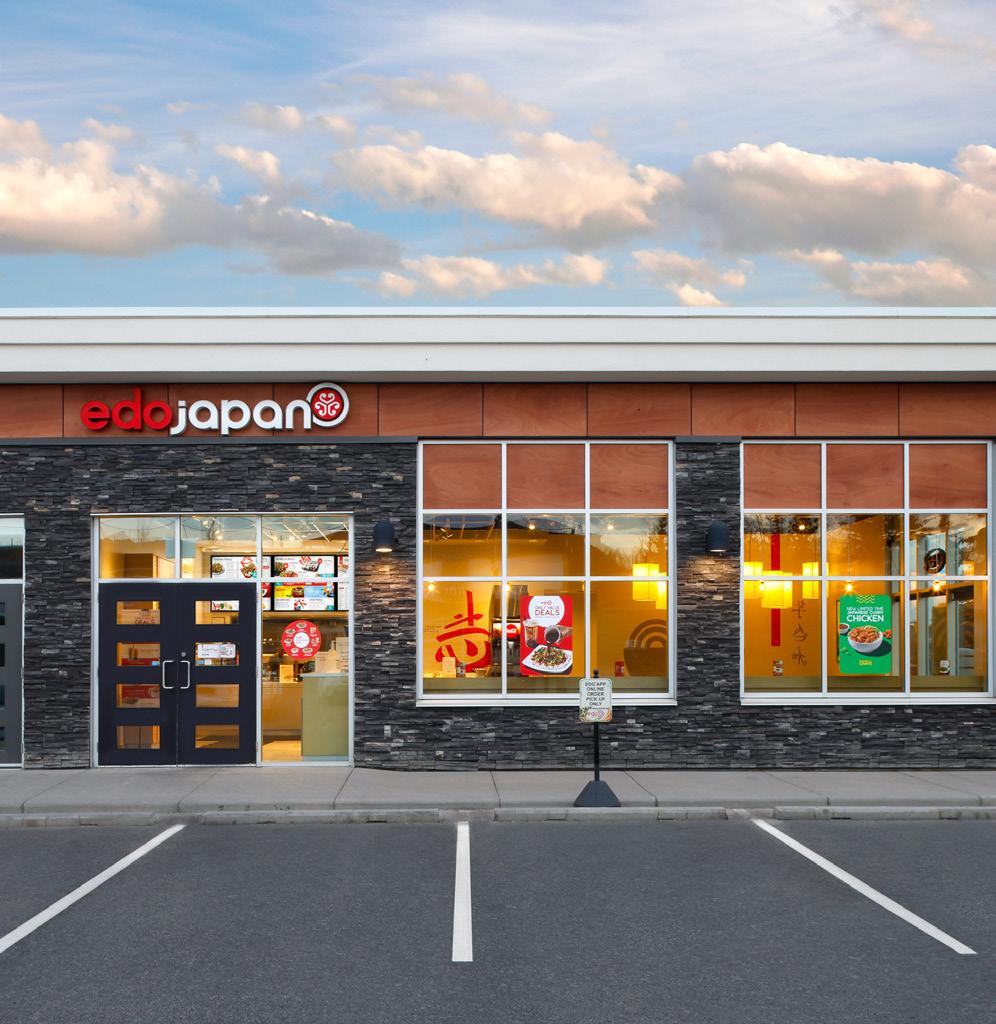
34 // Tariffs, Trends, and the Tactics to Help Navigate 2025
Uncertainty is nothing new for thoseoperating within the Canadian retail industry. Businesses continue to feel the pinch of stretched consumer budgets and a hyper-promotional environment that’s bringing forth added pressures on margins and cash flows. But now, with persistent inflationary stressors and the looming threat of US tariffs, what’s a retailer to do to find success in 2025? We take a look at a couple Canadian retail success stories to find the answers.

The past five years haven’t been easy for Canadian retailers. From changing consumer spending habits to tariff threats, retailers have faced a number of challenges. But CBRE Vice President Kate Camenzuli, says it’s not all doom and gloom.
Craig
EDITOR-IN-CHIEF
Sean
GRAPHIC DESIGN
GBC
CONTRIBUTORS
George Minakakis, Jocelyn Rhindress
Mario Toneguzzi
HEAD OF SALES AND SPONSORSHIP
Darryl Julott darryl@retail-insider.com
EDITORIAL OFFICE
100 Bloor Street West, Toronto, ON, M5S 3L3
Retail


June retail sales rise modestly despite May weakness
Advanced estimates from Statistics Canada reveal that retail sales likely rose 1.6% in June after a 1.1% drop in May, signaling stabilization despite ongoing trade tensions with the U.S. and subsequent consumer caution.
+1.6%
projected increase of retail sales in Canada for June
Canada Goose posted a larger-than-expected quarterly loss, but revenue surged 22.4% year-over-year, driven by strong international sales.
22.4% increase in overall year-over-year sales
45.4% increase in U.S. revenue
18.7% increase in Greater China sales
-1.1%
retail sales in Canada decreased in May after April gains




According to recent data from Statistics Canada, the country added 83,100 jobs in June, including 33,600 in the retail and wholesale sector. This marks the first sustained employment growth since January, suggesting cautious optimism amid retail challenges.
83,100
number of jobs added to Canadian landscape
+1.1% increase in retail and wholesale employment
33,600 new jobs are found in retail and wholesale
+0.8% increase in employment among men aged 25-54
60.9% current employment rate in Canada
+0.4% increase in employment among women aged 25-54
Recent study estimates that existing internal trade hurdles cost the Canadian economy around $200 billion annually. These interprovincial barriers function like a tariff, leading to price increases between for goods and services across provinces. The inefficiencies stifle business productivity, limit market access and reduce consumer choice. Removing these trade restrictions could increase Canada’s GDP by up to C$161 billion—a 7.9% boost—with long-term potential gains reaching C$200 billion. The economic benefits span industries such as manufacturing, retail, and logistics, highlighting the urgency of reform to strengthen national economic resilience amid global trade challenges and domestic cost pressures.
KPMG Canada recently released a report titled In-store shopping still reigns supreme for Canadians’ that revealed results of a consumer survey conducted in December 2024/ January 2025. And, based on the data, it seems Canadians still love to shop in-person with their favourite brands.
67%
Artificial Intelligence/ Machine Learning
85%
Edge Computing (including the Internet of Things)
90%
Virtual Reality/ Augmented Reality


57% 49% Robotics/Automation
Quantum Computing
78%
Web3 Technologies (including tokenization)
Loblaw plans to install an 8.5 M kWh rooftop solar facility at its East Gwillimbury distribution centre—one of the country’s largest solar retail investments—operational by 2026. This reflects a growing trend toward sustainable retail infrastructure.
25% of total energy used at facility will be generated by array
435,000 installation will cover approximately 435,000 square feet of roof space
7.5 MW
strength of the rooftop solar system providing energy
8.5M KWH
amount of clean on-site power generated annually by the solar system

Ensuring that customers understand the significant impact that buying local can make is key to continued success
// By Michelle Auger, Senior Policy Analyst, CFIB, Canadian Federation of Independent Business

With trade tensions between the U.S. and Canada continuing to rise, Canadian small businesses are feeling the pressure. According to a recent survey by the Canadian Federation of Independent Business (CFIB), four in five small firms are experiencing tariff-related impacts—everything from rising costs (51%), a weaker Canadian dollar (39%), pricing challenges (37%), and reduced profits (35%).
In response, small businesses are pivoting and searching for ways to mitigate the impacts, with many increasingly turning toward domestic markets (32%), promoting Canadian-made products (26%), delaying expansion plans (23%), raising prices (21%), and even exploring markets outside of the U.S. (19%).
Today, half of Canadian small businesses do not consider the U.S. a reliable trading partner. As a result, many entrepreneurs are already shifting their investment focus away from the U.S. and toward Canadian and international markets over the next six months. But the reality is that North American supply chains are deeply interconnected.
Many small businesses continue to carry U.S. products, which is not necessarily out of preference, but because sourcing alternatives takes
significant time and resources. While businesses are working to diversify their supply chains, it’s critical that we don’t penalize small firms that still rely on U.S. goods or that still have leftover inventory. Instead, we must support them as they navigate this complex transition.
In some cases, support is paying off. One especially encouraging and effective strategy is when businesses actively promote Canadian-made products. In fact, a quarter of all small businesses—and a notable 43% of retail firms—have already taken steps to highlight Canadian-made products. Among those that have, half of businesses reported increased customer demand, double the rate of businesses overall. Clearly, Canadian consumers are paying attention.
But here’s the catch. While “Buy Canadian” movements are well-intentioned, they can lead to unintended side effects. There’s a smarter, more impactful way to support our economy: buying local.
It’s important to recognize the difference between buying Canadian-made and buying from a Cana-
dian-owned small business. These aren’t always the same thing. Even if a product isn’t made in Canada, or a business operates under a U.S. franchise or carries American goods, shopping at small businesses can still make a big local impact. Supporting local businesses means supporting your neighbours—real people who are entrepreneurs in your community, creating jobs, and reinvesting in our communities. When we choose to shop local, we’re not just helping an individual business owner—we’re keeping our communities vibrant and economy resilient. In fact, for every dollar spent at a small business, 66 cents stays in the local economy. Compare that to just 11 cents when a dollar is spent at a large multinational.
As trade challenges persist and Canadian consumers look for ways to make a difference, let’s remember: the most powerful way to “shop Canadian” is to shop local. Let’s focus on where we buy!
CFIB has created free digital toolkits that include printable posters and customizable social images

for business owners to display and promote the power of shopping local.
Michelle Auger is Senior Policy Analyst, at the Canadian Federation of Independent Business

As consumers all over the globe pullback on spending, it’s up to retailers to do more to ensure their continued business
// By George Minakakis, Founder and CEO of Inception Retail Group, and Author of
What the public doesn’t realize is how intertwined global trade is today. Implementing tariffs even the benevolent 10% pause, will filter through supply chains and ports raising prices globally. Now throw in a trade war with China, on top of 25% tariffs on Canadian steel, aluminum, autos and soon parts. All of this will impact consumers, all industries and associated businesses.
The bigger problem is that this is about deconstructing global trade as we have known it to operate. This is ill conceived and has many risks even for the USA, their strong economy will experience fallout. The notion of repatriating companies back on US soil, attracting foreign companies, or economically coercing companies of other nations like Canada to relocate, is nothing short of making the USA the center of all trade and commerce. In effect making all other nations a subsidiary and dependent to their economy.
If companies are to build more factories in the US, to make them economically viable, they will do it with investments in AI and automation not more jobs. To adjust to a new global trade system many companies globally must accelerate their technological transformations if they want to remain competitive and relevant.
Retailers will have to rethink how they source

supplies, ensure they understand shipping lanes, port corridors and their costs. Retailers will also have to take risks and experiment with new product lines from new markets and manufacturers in addition to building supply chain agility. As prices rise the pressure to diversify products and reduce costs will come hand in hand with the need to remain competitive, market visible and relevant. That means finding ways to be more productive in your operations and mostly in the back of the house. Elevate your branding marketing by telling and sharing your brand story. That’s what consumers want, a compelling reason to have a connection with a brand.
This is both a crisis and a transformational period, which is in a state of chaos and remains fluid. Consumers will be pulling back on their spending, their focus will be on food, shelter, debt servicing and health needs. Any discretionary spending will be curbed to cover unexpected incidentals. The post pandemic global impact of inflation and higher interest rates is still impacting many of them. Which means when it comes to any kind of discretionary spending it will be a cost-conscious decision. And we should not be surprised that online asks for information,

browsing and shopping will increase as price will be a determinant for many. Retailers should not sacrifice quality and consistency, but they should add alternative options, a good, better, best approach to draw more customers to their brand.
The plight of retailers will be better than that of HBC and others who have failed to manage forward in and remaining relevant with consumers. Success lies in not chasing profits as your sole outcome, nor is it wise to stop spending in marketing because the market is slow. That’s when you need to spend effectively and in a targeted way. How do you do that? Collect data, it is more precious than gold. Knowing where your customers will be and what they pay attention to opens the door for business survival in tough times. Couple all of this with AI, human and business intelligence and you are in a better position than most.
As this situation evolves we can be assured that many organizations are looking at how AI and Automation can enhance their operations and competitive advantages. The challenge is on for
management to demonstrate that they can do more with the AI capabilities they are investing in.
The role of government is to protect the Canadian economy. I have said this to many in the media, we need a war time like mentality adopted by government and industries to work together and redirect our economy. However, to be clear we need to do more than just redirect the oil and gas industry because on a GDP level it only represents about 6%. The balance of the Canadian economy is much larger and broader. Therefore, it’s important in helping consumers raise their economic well-being. And that means investing in projects that will create jobs and entice both foreign and domestic investments. For that kind of growth, we will have to make sacrifices.
George Minakakis is the CEO of Inception Retail Group, author of three books, and keynote speaker.

As economic uncertainty deepens and profit margins remain under pressure, 2025 has proven to be another demanding year for the restaurant industry.
// By Chris Elliott, Chief Economist and VP Research, Restaurants Canada
To stay competitive, today’s restaurant owner must be more agile than ever—quickly adapting to evolving guest expectations and market shifts. To help restaurants understand emerging trends, Restaurants Canada and Circana put together a list of their hot 10 restaurant trends (in no particular order).
1. Coupon culture is on the rise. Given the current affordability crisis, it’s not surprising that three in 10 Canadians said they are using coupons and discounts more than ever before. Younger Canadians, and especially Gen Z, are the biggest users of coupons and discounts, with some searching on Google and TikTok for restaurant promo codes.
2. Value and dealing. Along with the continued popularity of coupons, combos are the most popular deal type. People are not necessarily looking for low price, they seek value for their foodservice dollars.
3. Affordable luxury. In past economic downturns, Canadians tended to shift their spending from more expensive table-service restaurants to less expensive ones. Today’s consumer is looking to feel good and wants an elevated experience in

these uncertain times. They want an indulgence and are unwilling to give that up.
4. Emerging chains. New restaurant concepts and global cuisine are taking share from the established legacy players, especially in quick-service restaurants. These emerging brands appeal to the shifting ethnic profile of Canadians who are looking for familiar cuisines.
5. Loyalty - Loyalty programs are used to attract and retain guests. Younger Canadians are the most active participants in loyalty programs. They appreciate the personalized, value-rich experiences loyalty programs provide, underscoring their growing importance in the industry. Still, there is room to grow as Americans have signed up to more restaurant loyalty programs than Canadians.
6. Digital ordering - Digital ordering is a popular, effective and important component of the overall restaurant experience. But it has not taken over the industry as was predicted by some in 2020. The recent uptick in digital ordering is due to a lift in delivery. As people look to save some
money on restaurant visits, delivery offers a more affordable option. It allows them to supplement their meal with beverages and other add-ons from their pantry or refrigerators, while also skipping the cost of the tips, parking, babysitter, etc.
7. Plant-based options. Nearly half of South Asian Canadians say when purchasing a meal or a snack from a restaurant, plant-based/vegetarian/vegan dishes are important or very important to them. Demand for plant-based options on menus is expected to grow as the population of people of colour is expected to double between 2021 and 2041.
8. Shifting Demographics. As the fastest growing generational cohort in foodservice, it is important to understand Gen Z’s restaurant behaviours. Gen Z are big fans of digital ordering and appreciate the quick convenient access to their favourite brands, especially QSR and Retail brands that specialize in grab and go convenience.

9. Data: the secret sauce to your success. You can’t win in the restaurant industry, either in the battle for customers or employees, without data. With half of restaurant companies currently operating at a loss, it’s more important than ever restaurants benchmark their performance, analyze the latest trends and track competitors’ activities.
10. Chicken sandwiches. Chicken sandwiches have consistently been one of the fastest growing food items over the past five years. Just about every channel of the market offers a chicken sandwich of some kind and this is especially popular among ethnic communities. Chicken sandwiches are also making their way into breakfast, both on their own, or as a substitute protein within a more traditional breakfast sandwich.
The Hot 10 Restaurant Trends report by Vince Sgabellone, Industry Analyst at Circana, and Chris Elliott, Chief Economist at Restaurants Canada, and the video are available at restaurantscanada.org/hot10.
POLICIES
Smart immigration policies offer a win-win solution by alleviating labour shortages and providing newcomers with valuable Canadian workforce experience.
Learn more at www.restaurantscanada.org or scan the QR code.

Browns Shoes President David Brownstein shares insights on the retailer’s growth, digital investments, and family-driven culture in this exclusive interview.
// By Craig Patterson
BrownsShoes, a legacy name in Canadian retail, continues to evolve under its fourth generation of family leadership, with David Brownstein officially taking the reins as President in early 2025. The Montreal-based company, founded in 1940 by Benjamin Brownstein, has become the largest independent footwear retailer in North America, with a uniquely Canadian identity and a strong focus on customer experience, design-forward offerings, and omni-channel innovation.
“I became President at the end of January this year,” said David Brownstein, who represents the fourth generation of family leadership. “My sister Julia oversees women’s buying, and my father, Michael, who led the business for nearly three decades, is now CEO. It really is a family business.”
Brownstein’s path to leadership was forged through experience in nearly every part of the organization. Starting by working part-time positions in stores in high school, he eventually moved through sales, operations, and executive leadership, becoming VP Sales in 2009 and Chief
Operating Officer in 2022 before assuming the presidency. “I’ve been with the company for 22 years, so this is a continuation, not a sudden change,” he said.
A National Retail Journey: From St. Catherine to Saskatoon
The company has seen a methodical yet steady national expansion. After his grandfather Morton Brownstein launched the Browns concept as we know it today in 1954 following a fire at the original store, the retailer took a major leap in 1975 by opening its first Toronto store at Toronto Eaton Centre.
“We’ve been expanding since 2008, and more aggressively since the pandemic,” David Brownstein explained. “Our strategy now includes relocating existing stores to better locations in malls and making them larger to enhance the customer experience.”
Recent upgrades include larger flagship stores at Yorkdale Shopping Centre and Square One in Ontario, a flagship at Royalmount in Montreal,

and a new store at Midtown in Saskatoon opening in June—marking Browns’ entry into that market. “We’re also reopening Scarborough Town Centre in a much bigger space, and we just reopened CF Fairview Pointe-Claire in Montreal, Park Royal in Vancouver and Southgate in Edmonton,” he said.
In total, Browns operates 71 stores across Canada, including 62 under the Browns and Browns OUTLET banners and nine under the B2 concept.
Filling the Void Left by Department Store Exits
The retreat of department stores in Canada has created a significant opportunity for Browns.
“Hudson’s Bay, Nordstrom, and even Saks Fifth Avenue carried many of the same brands we do. Their exits open space for us to grow and take market share,” said Brownstein. “There used to be a lot more footwear retailers in Canada—Town Shoes, Sterling, Pegabo, David’s Footwear, and more. We’re one of the few legacy names still here and expanding.”
“Our digital business is a growing piece of the pie. We’re investing heavily in our website and omni-channel experience. For many customers, BrownsShoes.com is their first interaction with our brand, so it needs to be seamless.”
The product offering spans everything from accessible sneaker brands to high-end designer labels. “It’s not common to find such a wide range within one store, but our customers respond really well to that,” he added.
Browns also takes a flexible approach to store assortments, tailoring the brand mix by location. “We make those decisions seasonally. Some brands are available in specific stores where they make the most sense.”
While Browns remains a strong bricks-and-mortar player, e-commerce has taken off—especially during and after the COVID-19 pandemic.
“Our digital business is a growing piece of the pie,” he said. “We’re investing heavily in our website and omni-channel experience. For many customers, BrownsShoes.com is their first interaction with our brand, so it needs to be seamless.”
That commitment includes modernizing customer service platforms. Browns has implemented Kustomer CRM to streamline support and improve satisfaction.
While the retailer currently only ships within Canada, Brownstein did not rule out future international expansion. “We’re open to new markets in the future, but for now, we’re focused on building our footprint in Canada.”
At the heart of Browns Shoes is a deeply rooted culture that emphasizes internal growth and long-term commitment.
“All our store leadership started as sales associates. We don’t hire from outside for those roles,” he said. “That’s something unique in retail.”
Many employees have been with the company for
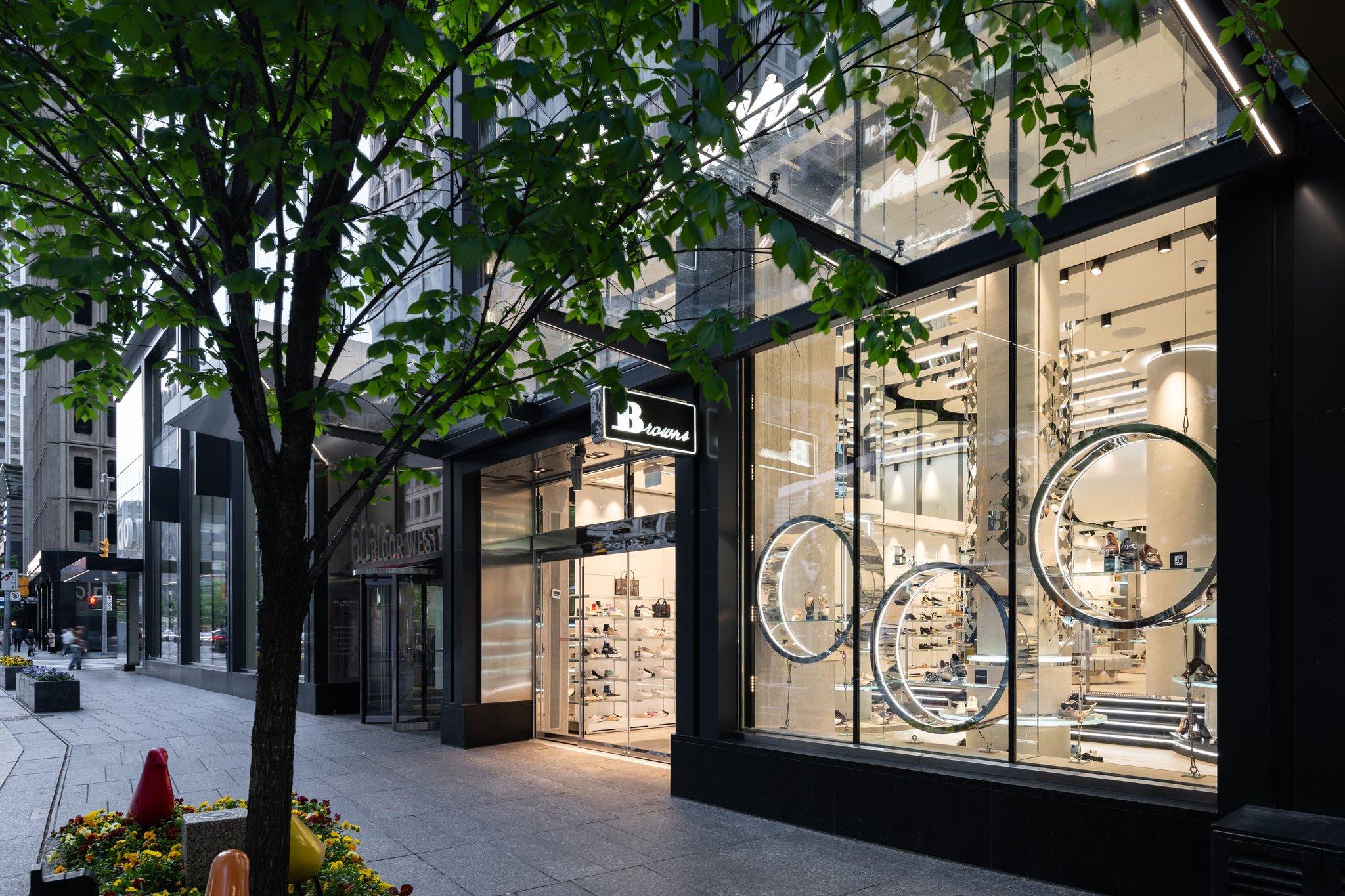
over 25 years, and multi-generational employment within families is not uncommon.
“We consider it a huge compliment when someone encourages their child to join us. It speaks to our values. In the past five years, we’ve also brought in many new, talented, specialized people in areas of business that have become much more important in retail like technology and digital. Our goal is to maintain that family feel as we grow and create an environment to thrive.”
This approach fosters consistency across the customer experience and aligns with the company’s ethos of treating team members like family.
Marketing Focus: Meeting the Customer Where They Are
Marketing at Browns has evolved to reflect changing consumer behaviour. “We’re trying to
raise awareness that we now carry top sneaker brands. Someone who hasn’t visited in years might not realize that,” Brownstein explained.
The retailer leverages digital channels and direct marketing—like email campaigns—to engage consumers, highlight trends, and showcase new offerings.
Adaptability is a hallmark of the brand. “Our merchandise has changed with fashion trends, and we’re quick to pivot,” he added.
The Sneaker Era: Comfort Drives Decisions
Sneakers continue to dominate the footwear landscape, and Browns is capitalizing on this.
“When a fashion trend is also extremely comfortable, it has a lot of staying power,” Brownstein said. Browns carries an extensive range of sneak-



ers, including large collections from On, Adidas, Hoka, New Balance, and Hugo Boss.
Navigating Uncertainty: Tariffs, Supply Chains, and Canada Post
While Canada has largely avoided the U.S. tariff wave, Browns remains alert to global risks.
“We’re not seeing any major impacts from tariffs right now, but we’re monitoring,” said Brownstein. “If U.S. prices go up because of tariffs, it could indirectly benefit Canadian customers.”
More immediately disruptive has been labour action at Canada Post. “The strike last November had an impact on E-commerce operations in general, but we were very well-prepared. We’re planning ahead for future disruptions to protect our customers and operations.”
Future-Focused: A Canadian Growth Story
Looking ahead toward the future, Browns is laser-focused on strengthening its position within Canada.
“We’re not targeting a specific store count. It’s about being the right size in the right locations, investing in technology, and ensuring an exceptional customer experience,” explained Brownstein. “We want to continue focusing on growing our market share, both with branded and exclusive products.”
With a strong foundation, loyal customer base, and thoughtful leadership, Browns Shoes remains a standout in Canadian retail—an enduring example of how legacy, innovation, and heart can move a company forward in a changing landscape.

Edo Japan’s Calgary roots and Canadian values guide its expansion as the brand grows across Canada and into the U.S.
>> By Craig Patterson
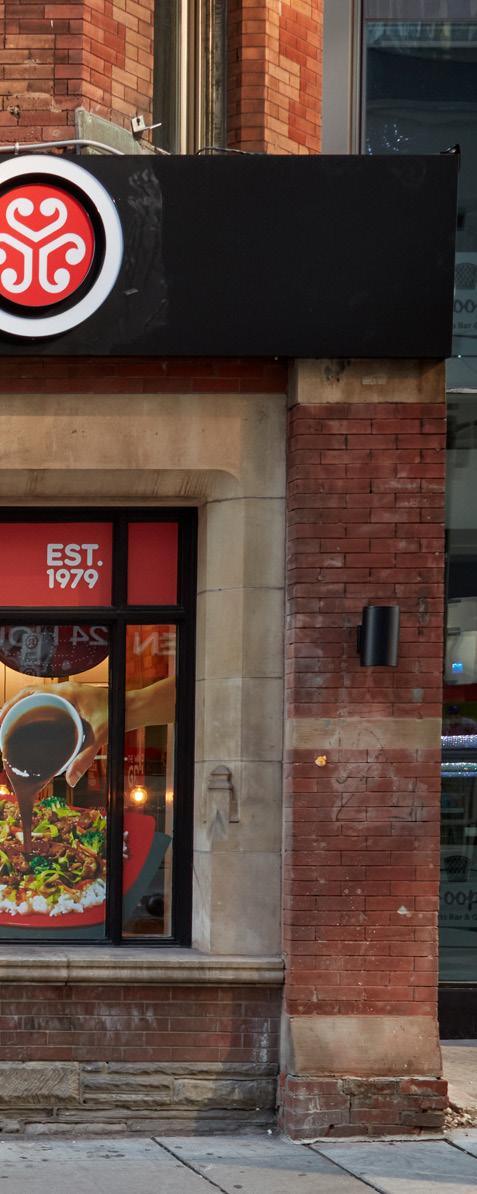
In a landscape filled with fast food options, one proudly Canadian brand has not only endured but grown by staying true to its roots. Edo Japan, the Japanese-inspired quick-service restaurant chain founded in Calgary in 1979, is quietly transforming the Canadian QSR industry with a mix of tradition, innovation, and values rooted in its Alberta origins.
“We’ve held on to the original foundation since day one,” says Dave Minnett, President and CEO of Edo Japan. “The same cooking style, the same teriyaki sauce recipe—it’s all still there.”
The chain’s origin story is deeply Canadian. The founder, Reverend Susumu Ikuta, a Japanese Buddhist minister, set out to bring Japanese cuisine to Canadians, launching the first Edo Japan in Calgary’s Southcentre Mall.
More than four decades later, that original location still operates, anchoring a network of more than 200 locations nationwide.
From the beginning, the model was designed not only to offer fresh Teppan-style meals but also to provide business opportunities through franchising, something the brand continues to champion. “We’re largely a franchise model,” Minnett explains. “Only six of our stores are corpo-

rate-owned. The rest are owned and operated by families and entrepreneurs across the country. That entrepreneurial spirit is something we’ve carried forward from our Calgary roots.”
Although the brand now operates coast to coast, it has never lost its Calgary identity, maintaining its head office in Calgary.
“You can’t help but be influenced by Calgary and Southern Alberta in your daily life,” Minnett reflects. “We test and learn in Calgary first before rolling out anything nationally. The customer base here is one of our largest, with 27 stores in the greater Calgary area alone. This city has helped shape our company.”
Minnett, who moved to Calgary from Ontario nine years ago, says he has fallen in love with the city. “There’s a warmth and hospitality in Calgary that I haven’t experienced elsewhere. That kind of attitude fits perfectly with our service-focused industry. It influences our team culture and customer experience every day.”
“Having vendors close promotes collaboration and quality control. It allows us to work hand-in-hand on continuous improvement, especially on things like menu innovation and logistics.”
Despite its growing national footprint, many Canadians are still surprised to learn that Edo Japan is a homegrown success story.
“It’s not always obvious that we’re a Canadian company,” says Minnett. “But when people find out, they’re pleasantly surprised. Canadians are proud to support Canadian brands.”
That pride extends beyond branding, as it’s embedded in Edo Japan’s corporate DNA. From Canadian-sourced ingredients to longstanding vendor relationships, the brand puts local partnerships at the forefront.
“We’ve built a supply chain that’s intentionally local. Our chicken is sourced from Maple Leaf Foods, our beef is Canadian, and even our signature teriyaki sauce is produced here at home. Supporting Canadian partners isn’t just a value— it’s a strategic choice that ensures quality, consistency, and trust in every meal we serve.”
Minnett describes the company’s culture as a reflection of Canadian values, inclusive, humble, community-minded, and quietly ambitious.
“Our partners, franchisees, and vendors all share similar values. We build long-term relationships, not just transactional ones,” he adds.
Edo Japan’s decision to prioritize Canadian suppliers is more than just patriotic. It’s also a strategic business move.
“Having vendors close promotes collaboration and quality control,” says Minnett. “It allows us to work hand-in-hand on continuous improvement, especially on things like menu innovation and logistics.”
He points to the brand’s long-standing part-
nership with Maple Leaf Foods as an example. “We’ve worked with their culinary team to explore new menu items. That level of collaboration is possible because they’re here in Canada.”
Minnett says COVID reinforced the value of Canadian partnerships. “During COVID, having local supply chain partners made a big difference. Everyone came together to solve problems and keep things moving.”
Expansion Momentum: Ontario, Maritimes, and Beyond
With its solid foundation in Alberta, Edo Japan has turned its attention to national and now international expansion. In 2024, the brand surpassed 200 locations, with ambitions to reach 275 by spring 2028.
“Our 200th store opened on Yonge Street in Toronto,” Minnett says proudly. “That was a milestone for us, not just for the number, but because it was our first major downtown urban location.”
Toronto location
The downtown Toronto location acts as a brand flagship. “We’re using it to build more awareness and test how we operate in dense urban markets,” Minnett explains. “It’s opened our eyes to opportunities in other cities like Vancouver.”
The company recently opened its first Maritime location in Fredericton and is ramping up expansion across Ontario with plans for 15 more stores in the province over the next 15 months.
Minnett confirms Quebec is also on the horizon. “There’s a clear appetite for Japanese cuisine in Quebec, and our research shows strong interest. That will be a major focus moving forward.”
Edo Japan also entered the U.S. market with a pilot location in Chandler, Arizona, earlier this
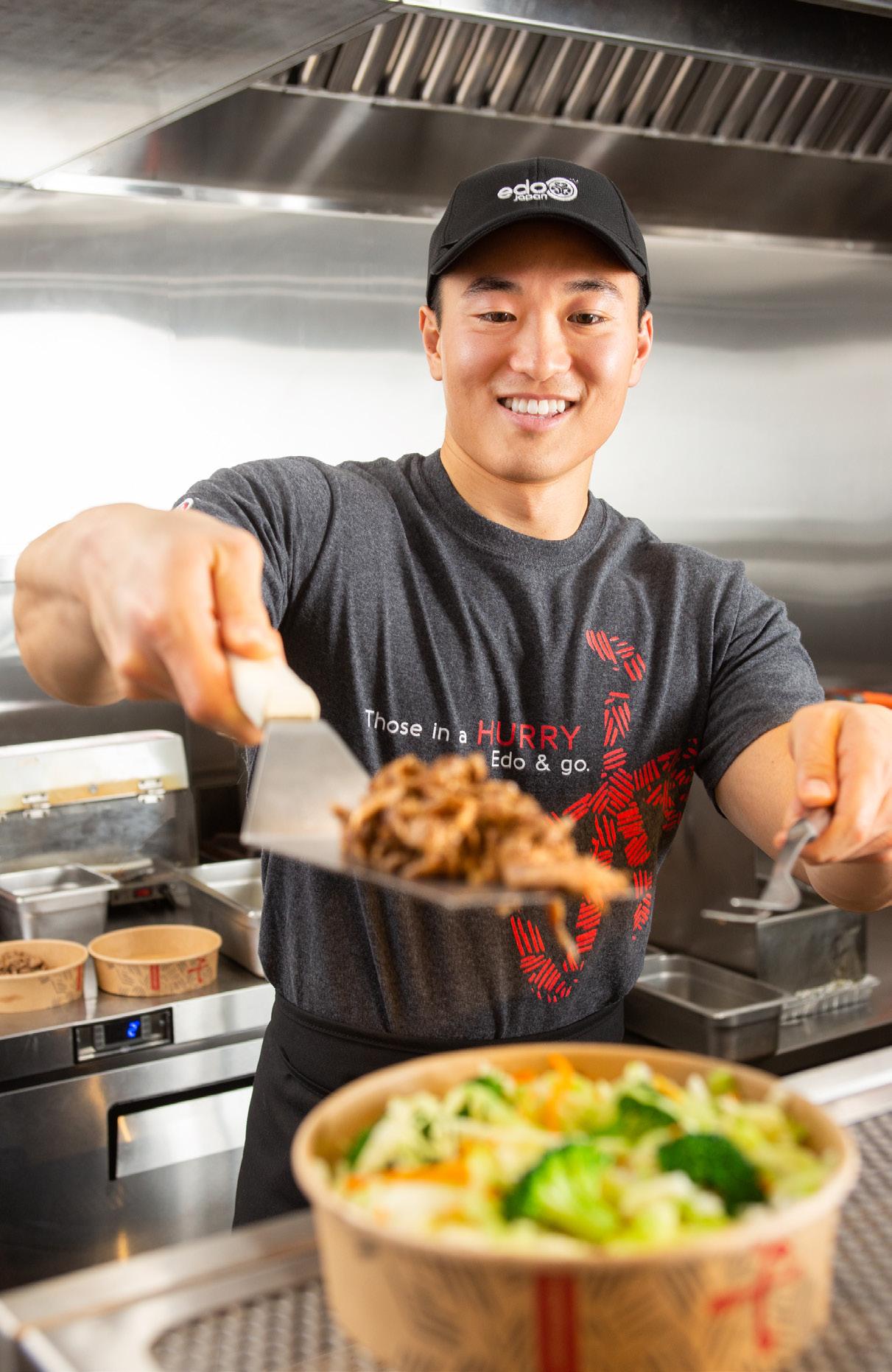
year. It marks the brand’s first foray outside Canada.
“We partnered with a Canadian family living in Gilbert, Arizona, who had experience in the restaurant space,” Minnett says. “We’re treating it as a joint venture, a way to test the model in a new environment.”
Two more U.S. locations have been planned by the company, one in Scottsdale Fashion Square and another in Gilbert, Arizona, in spring 2026.
“We’re tweaking portions and presentation to better fit American expectations, but the fundamentals remain the same,” Minnett explains. “We’re cautiously optimistic and very excited about our potential here.”
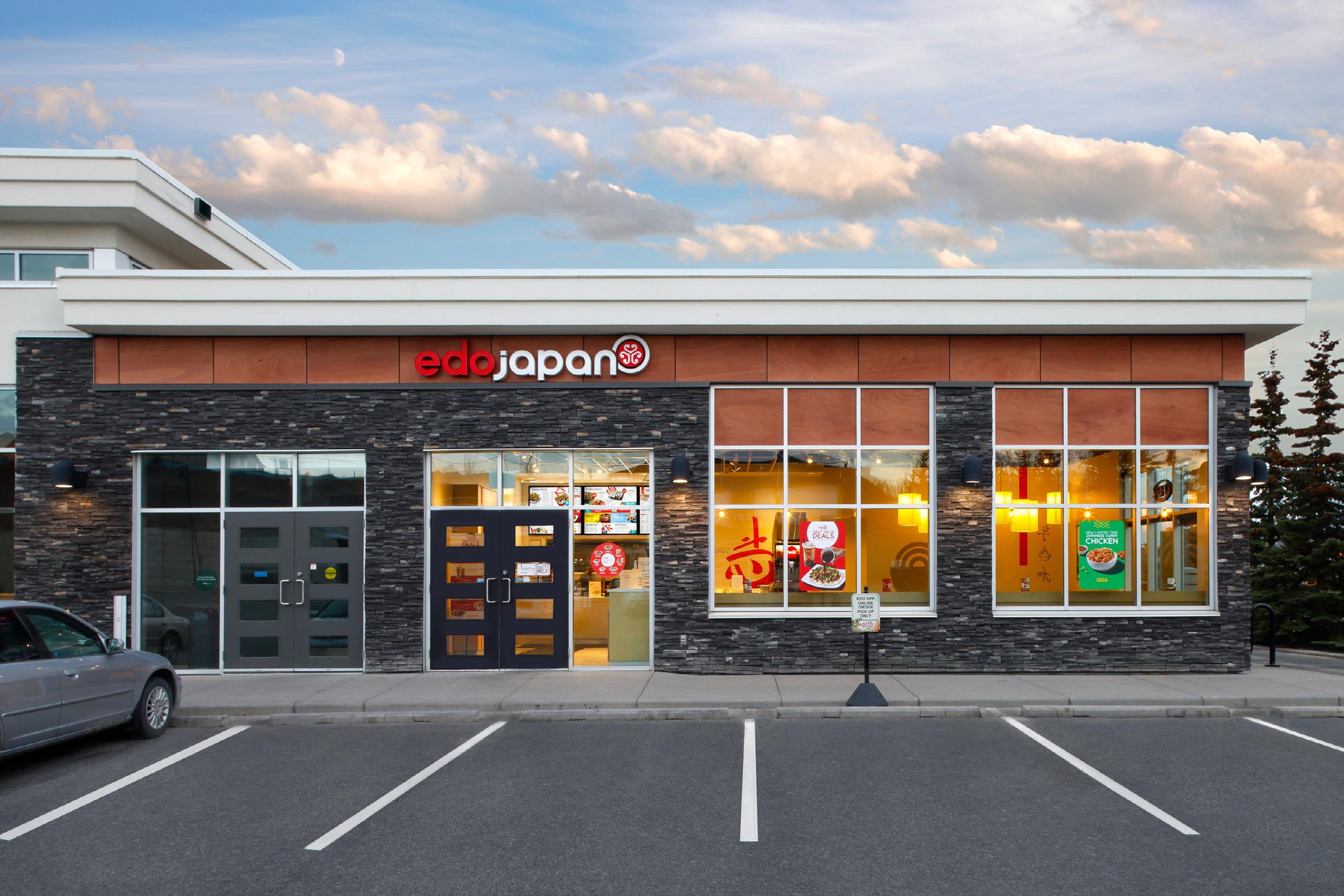

As the foodservice landscape evolves, so too has Edo Japan’s approach to menu development and technology.
“Our digital ordering channel now accounts for 30 percent of total revenue,” says Minnett. “We’ve invested heavily in our app, which allows for pre-ordering, loyalty points, and family meal bundles. It’s a game changer, especially for timepressed customers.”
The company also recently introduced poke bowls, a move that exceeded expectations and has secured the dish a permanent place on the menu. “It speaks to the younger demographic and broadens our appeal,” Minnett adds.
Bubble tea, introduced two years ago, is another growing category. This summer, Edo Japan is running a national campaign promoting $3 bubble teas to capture younger consumers.
“We haven’t marketed it much until now,” Minnett says. “But the reaction has been fantastic, so we’re getting louder about it.”
“We’ve been fairly quiet about it, but the response has been exceptional. With that kind of guest enthusiasm, it’s time to amplify the message and let more people know what we’re offering.”
In addition to menu innovation, Edo Japan is modernizing its physical spaces. The brand’s new “Fresh Take” design, originally launched in 2017, is getting an upgrade. The first prototypes of the new format will debut in Ontario this summer, starting with Oakville and Burlington, followed by a mall location in West Vancouver. “These next-generation stores will be our new standard,” Minnett says. “We’ll begin rolling them out across all new builds and renovations.”
With more stores and greater geographic reach comes the challenge of maintaining consistent customer experiences. For Edo Japan, it starts with franchisee selection.
“Cultural fit is critical,” says Minnett. “We make sure all our potential franchisees understand the day-to-day reality, sometimes that means shadowing existing operators before committing.”
Each new franchisee undergoes rigorous training at one of the company’s six corporate training hubs across Canada. On-the-ground support is equally important.
“In Ontario, for instance, we already have four corporate operations managers for just 22 stores,” Minnett explains. “We believe in having strong leadership close to the communities we serve.”
As Edo Japan eyes the future, the company’s goals remain ambitious but grounded. It says that it’s aiming to open 20 to 25 new stores annually, focused on thoughtful growth and franchisee profitability.
“Our approach is grounded in the Kaizen philosophy of continuous improvement. We’re always evolving but no matter how we grow, staying true to our Canadian roots will always be non-negotiable.”
That identity, shaped in Calgary and celebrated across Canada, continues to be Edo Japan’s most enduring ingredient. Whether it’s a new poke bowl, a store opening in Toronto, or a bubble tea deal, the brand’s expansion story remains unmistakably Canadian.
“We’re Canada proud,” Minnett says simply. “And we always will be.”

// By Craig Patterson
In a move set to reshape the retail packaging industry in Canada, Gather Packaging has officially launched as a new domestic manufacturer of premium, sustainable paper shopping bags.
Founded by Ben & David Hertzman, the owners of Progress Luv2Pak, which boasts over 100 years of experience in the retail packaging industry, the launch marks a return to Canadian manufacturing for the Toronto-based company.
“We started as a manufacturer,” said Ben Hertzman, President of both Progress Luv2Pak and
Gather Packaging, during an in-depth interview. “Our company has been around for over a century, originally making hat and gift boxes in the 1920’s for icons in Canadian retail.”
But like many companies, Luv2Pak exited local manufacturing roughly 15 years ago in favour of international sourcing. That trend has now reversed.
“What’s old is new again,” Hertzman continued. “We truly believe the future of production is bringing supply chains closer to home.”
Made in Canada: A Strategic Business Advantage At a time when global supply chains are riddled with unpredictability—from tariff instability to freight delays and added uncertainty—Gather Packaging offers retailers a safer, more stable solution: buying domestic.
“There are so many benefits to sourcing locally,” said Hertzman. “You reduce risk. You avoid unexpected disruptions. And you gain more control over timelines and quality.”
For Canadian retailers, this shift is not only about convenience—it’s also about branding. A “Proudly Made in Canada” paper bag is more than a vessel for purchases; it’s a walking billboard for values like sustainability, quality, and national pride.
“As patriotism grows, more retailers are telling us they want packaging that reflects their Canadian roots,” said Hertzman. “We’re here to deliver that.”
Located near York University in Toronto, Gather Packaging’s brand-new production facility is a multi-million-dollar investment in Canadian manufacturing. The plant features some of the most advanced printing and converting equipment available in the industry worldwide.
“We’re the only manufacturer in North America with the capability to produce a ‘turn top’ paper bag – the preferred style of many premium retailers,” said Hertzman. “This is in addition to the staple and most common ‘serrated top’ paper bag. We are also adding technology to add tamper-resistant adhesive tape for food or grocery delivery bags.”
Gather’s manufacturing process is highly automated, making our domestic production efficient and cost-effective. According to Hertzman, “The machinery takes care of most of the work. Our team loads giant rolls of paper at one end of the
machine, and thousands of bags an hour come out the other side. Just about everything is automated, which keeps our costs competitive.”
Gather Packaging isn’t aiming to compete with low-cost, low-quality imports from overseas. The goal, instead, is to elevate the standard for what a paper bag should be.
“A lot of paper bags you find are commodity-grade,” said Hertzman. “Print quality is average. Bags are rough. Handles may break or detach. That’s not what we do. Over 100 years of working with the top retailers around the world have taught us that manufacturing a superior quality product is the benchmark.”
Bags are printed with up to 8-colour, vibrant flexographic print, with options to adjust size and customize finishes. They’re rigorously tested in
“We’re the only manufacturer in North America with the capability to produce a ‘turn top’ paper bagthe preferred style of many premium retailers.This is in addition to the staple and most common ‘serrated top’ paper bag.”

an on-site quality control lab outfitted with advanced testing equipment to ensure consistency, strength, and reliability.
“Our bags can hold up to 40 pounds,” Hertzman added. “No more double bagging because you’re worried the handles will break or the bottom will fall out. Just using one high-quality bag where you used to use two is a huge win.”
While Progress Luv2Pak has long served some of the most iconic retailers across North America, Gather Packaging’s reach is intentionally broader. The new manufacturing operation is designed to serve any organization that relies on high-quality paper shopping bags, if they can meet minimum order quantities.
According to Hertzman, the company is focusing on three main customer groups. The first group is retailers, spanning categories such as apparel, gift, books, and toys. Both national and regional retail chains are ideal clients, especially those seeking to enhance their brand with durable,
aesthetically pleasing packaging. “We’ve worked with a wide range of retailers over the years, many of whom are featured regularly in Retail Insider,” said Hertzman, “we know how to meet the high expectations of brands that care deeply about presentation and performance.”
The second group includes grocers—particularly those who want to integrate Canadian-made paper shopping bags into their inventory for instore use or delivery. With more grocery retailers moving away from plastic and seeking sustainable, high-performing alternatives, Gather’s offerings are well-suited to meet that demand.
The third target group is the quick service restaurant (QSR) sector. Many QSR brands already rely on paper bags with twisted handles for takeout and delivery. Gather Packaging’s production includes options like tamper-evident adhesive strips, which are increasingly required for food safety and quality assurance. “These twisted-handle paper bags are a staple across retail, grocery, and foodservice,” said Hertzman. “Our versions are stronger, more attractive, and more customizable than most of what’s currently available.”
Gather Packaging’s machinery is best suited to chains and multi-location operators, rather than small independents. “Our factory is built for scale – the equipment we have invested in is geared for longer-run production. Specialization is key in manufacturing. We’re tooled to run truckload quantities of paper shopping bags” he added. “If you’re looking for a beautifully crafted, Canadian-made product that represents your brand and performs reliably, then we’d love to talk.”
With volatile global trade policies and increasing scrutiny of environmental impact, sourcing locally is becoming not just desirable—but necessary. “If there’s one certainty right now, it’s uncertainty,” said Hertzman. “Tariffs could change tomorrow. Freight rates can spike overnight. Buying from a Canadian factory means you’ve got one less thing to worry about.”
“Not only that, we source as many of our raw materials from Canada as we can. From Canadian paper to inks, glues, corrugated boxes – the more we can keep our supply chain at home, the more resilient and self-sufficient we can be.”
Environmentally Friendly and Fully
Sustainability isn’t an afterthought at Gather—it’s foundational. Every bag is 100% curbside recyclable, and the company uses FSC®-certified paper sourced from responsibly managed forests.
“With nimble material sourcing, we offer high percentage of post-consumer recycled content options to meet our customers’ specific needs,” noted Hertzman. “Our inks are water-based. Our glue and corrugated boxes are responsibly sourced. Sustainability is table stakes for us.” The factory itself is designed for efficiency and minimal waste, aligning with the values of eco-conscious clients and end consumers alike.
For retailers curious to see Gather Packaging in
action, the company offers both in-person and virtual tours of its Toronto facility.
“Every retailer who’s walked through has said ‘Wow,’” said Hertzman. “They see the spotless floors, the advanced machinery, and the beautiful bags coming off the line—it’s like nothing else they’ve seen in North America.”
The factory opened earlier this year, is currently in production of a large-scale order for a global apparel brand and is now accepting new clients, with production capacity expected to sell out.
Looking ahead, Gather Packaging plans to grow, but not at the expense of quality or service.
“We’ve built this plant to scale,” said Hertzman. “There’s room for more lines, more products. We’ll grow by listening to our clients and investing in technology that helps us meet their evolving needs.”
When asked what keeps him motivated, Hertzman points to legacy and innovation.
“This is about doing something meaningful here at home. We even managed to bring back some of our manufacturing staff; Progress’ long-standing Plant Manager returned after 15 years to work with Gather Packaging. That’s incredibly special.”
For retailers interested in learning more, the company encourages reaching out directly through its website at gatherpackaging.com, or contacting Ben Hertzman directly via LinkedIn or email ben@gatherpackaging.com
“We’re proud to be doing this in Canada,” said Hertzman. “We’re building something that’s not just beautiful but built to last—and built close to home.”
Canadian foodservice giant Foodtastic in system sales and continues aggressive acquisitions and global franchising.
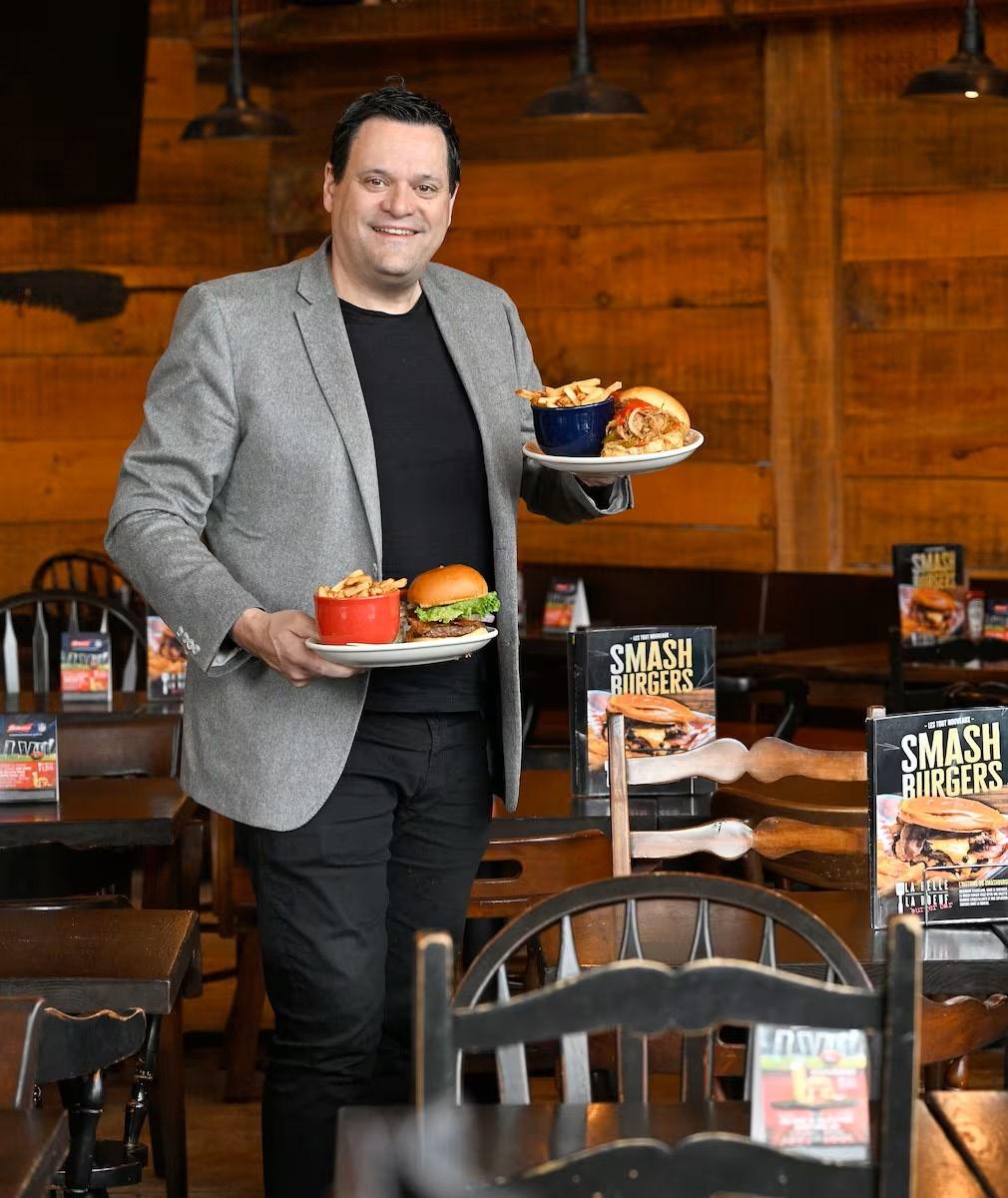
Foodtastic surpasses $1 billion aggressive expansion through franchising. //
By Craig Patterson

Foodtastic, one of Canada’s most dynamic restaurant companies, has officially surpassed $1 billion in system-wide sales, solidifying its position as a leader in the country’s competitive foodservice industry. Founded in 2016 by longtime restaurateur Peter Mammas, the Montreal-based company now operates more than 1,200 restaurants across Canada and internationally, with no signs of slowing down.
“What we’ve accomplished in eight years is something I sometimes have to stop and take in,” said Mammas in an exclusive interview. “We’re by far the quickest Canadian restaurant company to hit a billion in sales. For comparison, it took MTY or Cara (now Recipe Unlimited) over 20 years to do what we’ve done in less than a decade.”
Mammas has been involved in the restaurant business for decades. His first major venture was a chain called Nickels, which launched in 1990 in partnership with well-known Canadian celebrities Céline Dion and René Angélil, along with his brother and business partner Paul Sara. That original venture expanded into a portfolio of six brands, which they later sold in 2007.

After a brief semi-retirement, Mammas quickly found himself missing the action.
“I got bored,” he said. “So, around 2012 or 2013, I opened a small restaurant. Then we added a Greek concept, and eventually, we brought back Nickels. That’s when the idea for Foodtastic came together.”
Incorporated officially in 2016, Foodtastic was designed to be a platform for growth—through both brand creation and acquisition. “We had franchising experience, we had the infrastructure, and we knew how to scale,” said Mammas.
By early 2020, Foodtastic had grown to approximately $100 million in system-wide sales. But then the COVID-19 pandemic hit. “Our sales dropped by 90 percent in one week,” recalled Mammas. “It was terrifying.”
Rather than freeze operations, the company pivoted quickly to third-party delivery. By May 2020, it was back in the black, albeit modestly. “At
“It was a brand in distress, and COVID made it worse. We rebranded it, refreshed the beverages and food, and now we’re opening close to 20 new locations a year.”
that point, we had a decision to make,” he said. “We figured someone somewhere was going to find a vaccine, and we decided to double down.”
Foodtastic invested $50 million into acquisitions during the pandemic, betting on a strong recovery. That gamble paid off. The company purchased several established yet struggling brands—including Second Cup, Milestones, and Pita Pit—and began turning them around.
“It turned out to be one of the best decisions we’ve made,” said Mammas.
When Foodtastic acquired Second Cup, the Canadian coffee chain was facing serious headwinds.
“It was a brand in distress, and COVID made it worse,” said Mammas. “We rebranded it, refreshed the beverages and food, and now we’re opening close to 20 new locations a year.”
Mammas also emphasized the importance of Canadian ownership. “Second Cup is now the only true Canadian coffee chain. Tim Hortons is owned by a Brazilian company, and Starbucks is American. So a lot of Canadians are resonating with Second Cup again.”
Foodtastic’s brand portfolio has grown significantly since 2016, now including well-known names such as Milestones Grill & Bar, Freshii, Shoeless Joe’s, La Belle & La Bœuf, Quesada Burritos & Tacos, Copper Branch, and Noodlebox.
The latter, a Vancouver-based Asian fast-casual concept, has proven to be one of the group’s fastest-growing brands since being acquired last year.
“Noodlebox is doing great,” said Mammas. “Freshii, which we also fixed after some turbu-
lence, is now performing well. And then there’s Jimmy John’s—our first major U.S. brand to come north.”
Foodtastic opened its first Jimmy John’s in Toronto in 2024, with 14 more locations expected to launch across Ontario and Winnipeg in the coming year.
While Canada has been Foodtastic’s primary growth market to date, international expansion is becoming a key part of the strategy.
“We already have about 200 international locations, mostly inherited through acquisitions,” said Mammas. “But now we’re going more intentional with global expansion.”
A recent deal with a French company will see Pita Pit expand across France, while Rôtisseries Benny recently launched in Shanghai under a franchise agreement—marking Foodtastic’s official entry into Asia.
For the first time, Mammas is also looking south. “We’re now actively exploring U.S. acquisitions and bringing our Canadian brands down there. The plan is to also bring successful American brands back to Canada.”
Managing this kind of growth requires more than strategy. According to Mammas, it’s all about people.
“I had to learn how to let go,” he said. “This is the first time I’ve run a company this big. At a certain point, you can’t have full control. You have to trust people.”
Foodtastic’s leadership approach is focused on hiring the best talent, empowering them to make decisions, and staying nimble.
“Without great people, we couldn’t have grown this fast. That’s the truth,” he said. “You need people who are not only skilled, but passionate. That’s what fuels everything.”
Looking ahead, Foodtastic’s strategy remains two-pronged, consisting of organic growth of approximately 10 per cent annually, coupled with another 15 to 20 per cent on top of that from acquisitions.
That would mean growing at a 25 to 30 percent pace each year, a trajectory that would take the company to an estimated $2.5 to $3 billion in system sales within five years.
“We’ve got a clear roadmap,” said Mammas. “We want to scale brands, not just buy them. That means making significant investment in product, operations, marketing, and support for our franchisee.”
A Canadian Champion in a Global Arena
At a time when many of Canada’s most iconic foodservice brands have been sold to foreign ownership, Foodtastic is positioning itself as a proudly Canadian alternative with global ambitions.
“Canadians want to support Canadian,” said Mammas. “And that’s become a big part of our identity—not just with Second Cup, but with the whole portfolio.”
The company’s headquarters remain in Montreal, where its central team oversees brand management, real estate, franchisee relations, operations, and acquisitions.
“I still get excited every morning,” Mammas admitted. “It’s hard to believe sometimes what we’ve built, but I’m more excited for what’s coming next.”

Retailers are currently being challenged by a number of different factors that are threatening their ongoing growth. However, there are a few examples throughout the industry that brands can look to in order to find success in 2025 and beyond // By Craig Patterson
Uncertainty is nothing new for Canadian retail – businesses continue to feel the pinch of stretched consumer budgets and a hyper-promotional environment that’s bringing forth added pressures on margins and cash flows – but now with persistent inflationary stressors and the looming threat of US tariffs, what’s a retailer to do to find success in 2025?
These challenges, and many others, require retailers to become more vigilant about their strategies
and how to seize opportunities to maintain profitability. This is certainly true for the leadership teams at La Vie en Rose and Rudsak, two of Canada’s most recognizable brands, and longstanding clients of Richter. Rudsak and La Vie en Rose have faced similar challenges — both external, like economic pressures, and internal, like adapting their customer engagement models — and their journeys each highlight the importance of adaptability, discipline, and focus, in an evolving retail environment.
In 2025, a key area of concern for retailers is how to enhance the customer experience, ensuring consistency across both physical stores and e-commerce platforms. This is a prominent theme for both La Vie en Rose and Rudsak, whose focus on customer loyalty and personalized service has helped them weather shifting market conditions.
La Vie en Rose has worked attentively to stay true to its core customer base, focusing on delivering consistent experiences that prioritize diligence in pricing and product offering. According to François Roberge, La Vie en Rose President and CEO, it is about “respecting our customers and keeping a focus on what we do best,” rather than trying to broaden product offerings just to diversify. “While it seems like everything is moving faster and faster these days, one thing remains constant to us: appreciating our customers, and treating them with respect,” says Roberge. Their mission emphasizes authenticity and confidence—values that have resonated with their loyal customer base for years.
Rudsak’s success similarly hinges on knowing its customers and providing a personalized, in-store experience. “It is about understanding how to connect with your unique customer. What works for one may not work for the next,” says Evik Asatoorian, President and Founder of Rudsak, which recently made a big investment with Shopify and now has an integrated, sophisticated POS system. “With customer profiles and order history, we have customer data at our fingertips, enabling us to customize in-store experiences even more,” says Asatoorian. This omnichannel approach has helped Rudsak deliver exceptional customer service and build lasting relationships.
The shift towards e-commerce has prompted many retailers to reassess their positions on real
estate. While online sales are essential, brick-andmortar stores remain a vital part of the customer experience. This is a position La Vie en Rose believes in firmly, “many brands have focused their efforts on being online, which is certainly important, but have neglected the importance of storefronts and in-store experiences. True omnichannel is the future of retail, but there must be a balance of brick-and-mortar and e-commerce to achieve success,” notes Roberge.
Retail advisory expert and Richter partner Vanessa Velentzas emphasizes the ongoing importance of brick-and-mortar stores, noting that the in-person brand experience cannot be matched online. “Retailers must reevaluate their real estate strategy to ensure their locations and footprint align with changing consumer behaviour,” she explains. “Retailers should consider things like lease renegotiations in low-traffic locations or take advantage of more flexible terms, such as pop-up stores to test new markets. Ultimately, thoughtful strategies involve finding a balance; the online presence needs to be optimized while physical stores in key locations should continue to drive brand awareness and engagement.”
“Ultimately, thoughtful strategies involve finding a balance: the online presence needs to be optimized while physical stores in key locations should continue to drive brand awareness and engagement.”
- Francois Roberge, La Vie en Rose
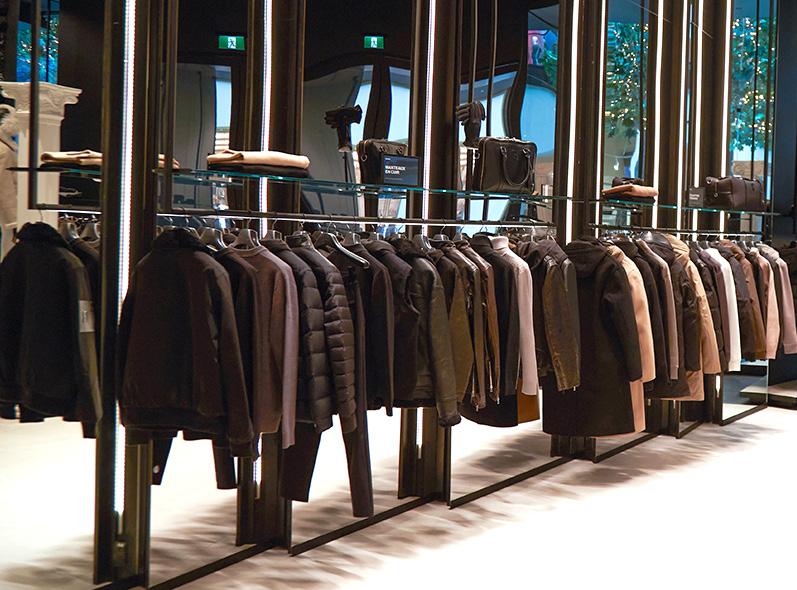
Another important element in finding the right retail-real estate strategy is how to balance the transactional with the emotional. Rudsak’s instore, personalized service is an essential touchpoint, helping customers connect with the brand, and reinforces its reputation for trust and quality. “We feel that this is incredibly important. Fashion is an emotional transaction,” notes Asatoorian.
Pragmatism, however, comes when decisions need to be made on actual locations. For Roberge, each store location must contribute to the brand’s presence and profitability. Roberge advises, “I would rather be recognized as the best in lingerie and swimwear, more than anything else. The store itself is simply a place to do business. You cannot be emotionally attached [to the locations].”
In today’s climate, availability of cash flow will determine which retail businesses survive. Roberge notes, “retailers forget to manage money that is sleeping in inventory.” Velentzas agrees, saying “effective inventory management is crucial. Retailers must optimize inventory levels and focus on turning their inventory into dollars. Failing to do this will leave retailers with outdated inventory and limited resources to invest in projects that enhance customer experience, ultimately putting them at risk of losing relevance and falling behind more agile competitors.”
For both retailers, sustaining the right stock is a cornerstone for achieving future growth goals. With an ethos of quality over quantity, Rudsak keeps its inventory levels in check while ensur-



ing that the products it offers hold their value, further reinforcing the brand’s commitment to craftsmanship. For La Vie en Rose, Roberge also emphasizes the importance of keeping inventory at healthy levels and knowing when it’s time to let go, stating, “If it’s not working this year, it won’t next year. It’s better to take action rapidly”. This, for La Vie en Rose, is as crucial to remember in the day-to-day as it is for their future as they begin to execute their plans to expand into the US.
Regardless of what’s in store for 2025, both leaders agree that staying focused on the customer is essential to long-term success. As Asatoorian puts it, “focus on connecting to your unique customer, not the general mass,” highlighting the importance of understanding the customer’s specific needs and preferences. “Stay true to who you are and do it well,” he advises. “We understand and appreciate fashion influence, but will never compromise our brand to keep up with the volatility of trends. Quality and service are most important. People can see through the gimmicks.”
Roberge underscores the need to focus on financial discipline and customer engagement: “No cashflow, no projects. Pay your debts and focus on your business to avoid giving the banks leverage. Retail is a cashflow business, therefore
the health of your balance sheet is critical. Adopt a cash-focused mindset.”
“La Vie en Rose and Rudsak are pillars of Canadian retail, and we’ve been privileged to work alongside them for years as they’ve achieved goals, realized strategic visions, and established a groundwork for ongoing success,” says Velentzas. “Mr. Roberge and Mr. Asatoorian exemplify true leadership, with unwavering commitments to quality, authenticity, and putting the customer first.”
Richter is a Business | Family Office that provides strategic advice on business matters and on families’ financial and personal objectives across generations. With close to 100 years of experience advising at the intersection of family and business, Richter has developed an integrated approach to help private businesses overcome obstacles and build sustainable success. Whether for business, personal, or both, Richter is uniquely positioned to address the needs of Canada’s most successful entrepreneurs, private clients, business owners and business families, helping them chart a clear path to shape their legacies for the future. Richter’s multidisciplinary team continues to innovate to create value for its people, clients, and community throughout Canada and in the US.

Amid U.S. tariff threats, Canadian consumers are embracing a growing “Buy Canadian” movement, as retailers and brands adapt to the prioritization of homegrown products over American imports in key categories // By Mario Toneguzzi
As talk of U.S. tariffs heat up, something else is quietly bubbling across Canada: a shift in consumer behaviour that could reshape the fast-moving consumer goods landscape.
Reshaping loyalty and value
In the face of growing economic uncertainty and political tensions, a clear message is emerging from Canadian households: support homegrown products or go without, according to a NielsenIQ
(NIQ) recent report – Tariffs, Tensions, and the Rise of the “Buy Canadian” Consumer.
“Retailers and brands, take note—this is more than a moment. It’s a mindset. And it’s reshaping what loyalty, value, and national identity look like in the Canadian aisle,” it said.
“The “Buy Canadian” movement is a growing consumer-led shift toward prioritizing domestically made products over imported alternatives—
especially those from the U.S. Sparked by political tensions, trade disputes, and rising tariffs, the movement reflects a broader desire among Canadians to support their local economy, protect domestic jobs, and assert national pride through their purchasing decisions. And this movement isn’t anything to scoff at.
“A new NIQ study reveals that nearly half of Canadian consumers are taking a stand. From boycotting U.S.-made goods to choosing Canadian products even when they’re not the easiest or cheapest option, shoppers are putting their wallets where their values are. This sentiment is influencing everything from food and beverage categories to household goods, prompting both retailers and manufacturers to rethink their positioning in a climate where Canadian-made has become a competitive advantage.”
“Buy Canadian” may be more than just talk, said the report.
“This behavioral shift is starting to show up in self-reported shopping preferences—particularly in categories like beer, BBQ sauce, sugar substitutes, and low-alcohol beverages—areas that are important to Canadian Loyalists. Meanwhile, U.S. brands are seeing heightened risk as 45% of consumers are either Canadian Loyalists or American Good Avoiders. This is especially true in categories like wine, backache treatments, and processed cheese spreads, particularly among American Goods Avoiders, who are more likely to live in Quebec and skews older. This group has the highest average monthly spend of all which presents significant risk to U.S. products,” it said.
Made in Canada
In the report, Made in Canada: How are Canadians responding to U.S. Tariffs?, NIQ found:
Majority Awareness: Most Canadians are aware of the potential tariffs that may be imposed by the U.S. government.
Boycott Movement: Many Canadians state they will boycott U.S.-made products, refusing to purchase them regardless of availability or price. Impact Perception: 92% of Canadians believe tariffs will negatively impact daily life in Canada. Product Identification: Are Canadians finding it easy to identify “Made in Canada” products on the shelf? What are the potential implications?
Store Switching: A segment of Canadians is ready to switch to stores that make it easier to find Canadian products
“What matters is how they vote with their wallets. Some are going to say they’re not going to buy American products or they’re going to boycott them At the end of the day, we see it in the stores. We see the way they’re behaving,” said Mike Ljubicic, Managing Director of NielsenIQ Canada.
“Those people that are saying they are going to avoid or be a little bit more aware of what they’re buying and looking at things that are Product of
“What matters is how they [consumers] vote with their wallets. Some are going to say they’re not going to buy American products or they’re going to boycott them. At the end of the day, we see it in the stores.”
- NielsenIQ report
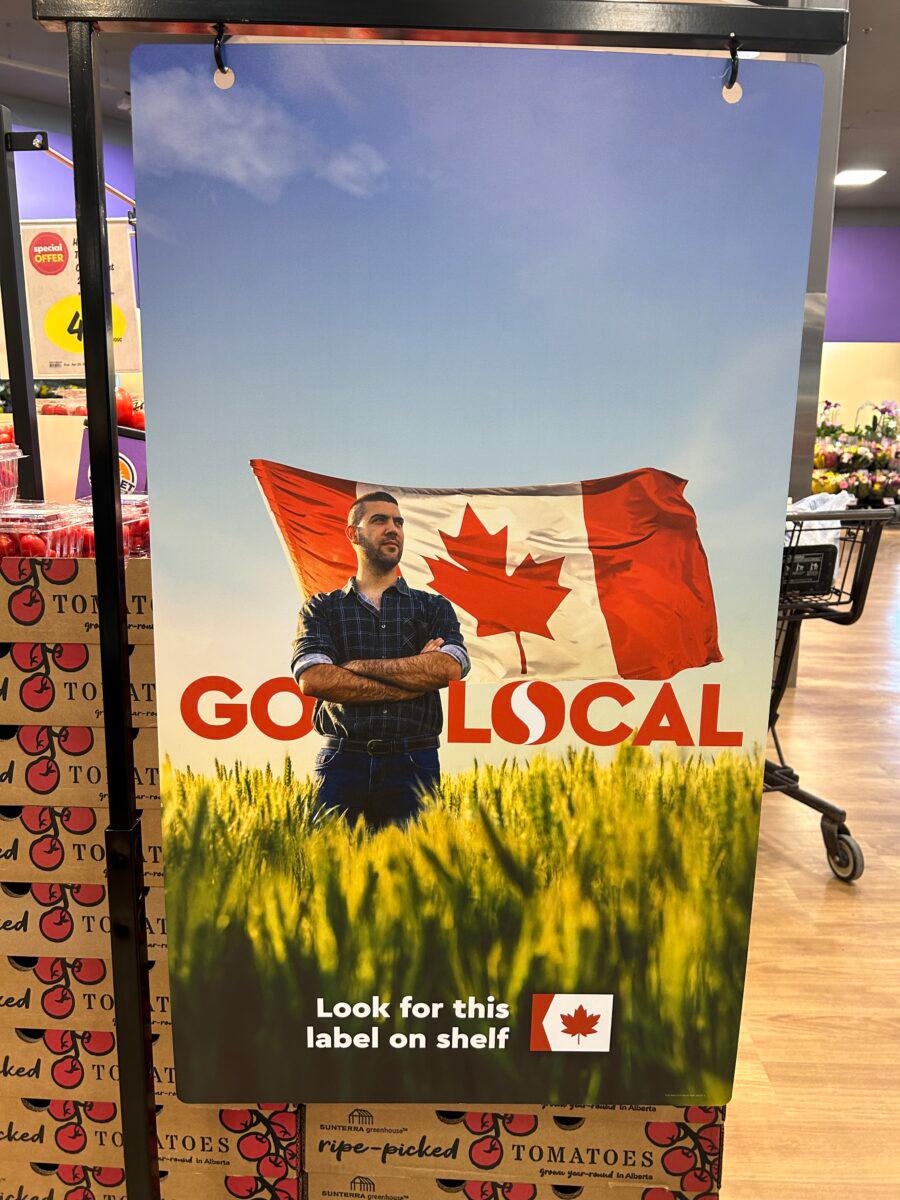
Canada or Made in Canada… they are voting with their wallets.”
He noted visible shifts in consumer behaviour across stores: “You probably saw yourself as you’re shopping—there’s people looking at apps, people looking at products in the stores.”
The movement is not limited to consumers
Major retailers and brands across the country are leaning into the trend with “Buy Canadian” signage and labeling.
And companies are taking advantage of that. You walk into a Safeway and there are big signs to Buy Canadian. Loblaw has products marked with a T to identify tariffs.
“I don’t think it’s a blip in time. I think it’s something that’s going to last. Now what the magnitude of it will be, I’m not sure,” he said. “But I
think it’s just adding to a snowball that already started.”
Changing consumer behaviour
Prior to COVID, consumer behaviour was cycli cal—shifting toward discount and private label during tough times, then swinging back as condi tions improved. But that pattern is changing. “What we’re seeing though in the last four or five years is consumers just have less money in their wallets,” explained Ljubicic. “Everything’s gone up—not just food. And people are just being more frugal with their money.”
Retailers have responded accordingly, expanding discount banners. “They’ve added well over 60 stores in those footprints in the last 18 months.” Notably, 50% of volume in Canada is now sold on promotion—double that of the U.S.
Rise of discount
Even more surprising? “The highest income households in Canada are growing penetration and baskets faster at those discount outlets than anyone else,” said Ljubicic. “That’s telling me that even people with the money are actually becom ing more frugal.”
Discount’s rise is more than a phase. “In 2008, discount was one-third of the market in Cana da. Conventional was two-thirds. Today, they’re 50/50—and discount’s going to tip the scale. It’s not going to revert back.”
Broader consumer mindet shift
Tariffs, then, are only one part of a broader shift in consumer mindset—toward frugality, local products, and price-conscious loyalty.
“It might be the opportunity where we’re going to see some Canadian brands emerge, local compa nies emerge,” said Ljubicic. “And if they can stay price-competitive, I think people will continue to vote and support that moving forward.”
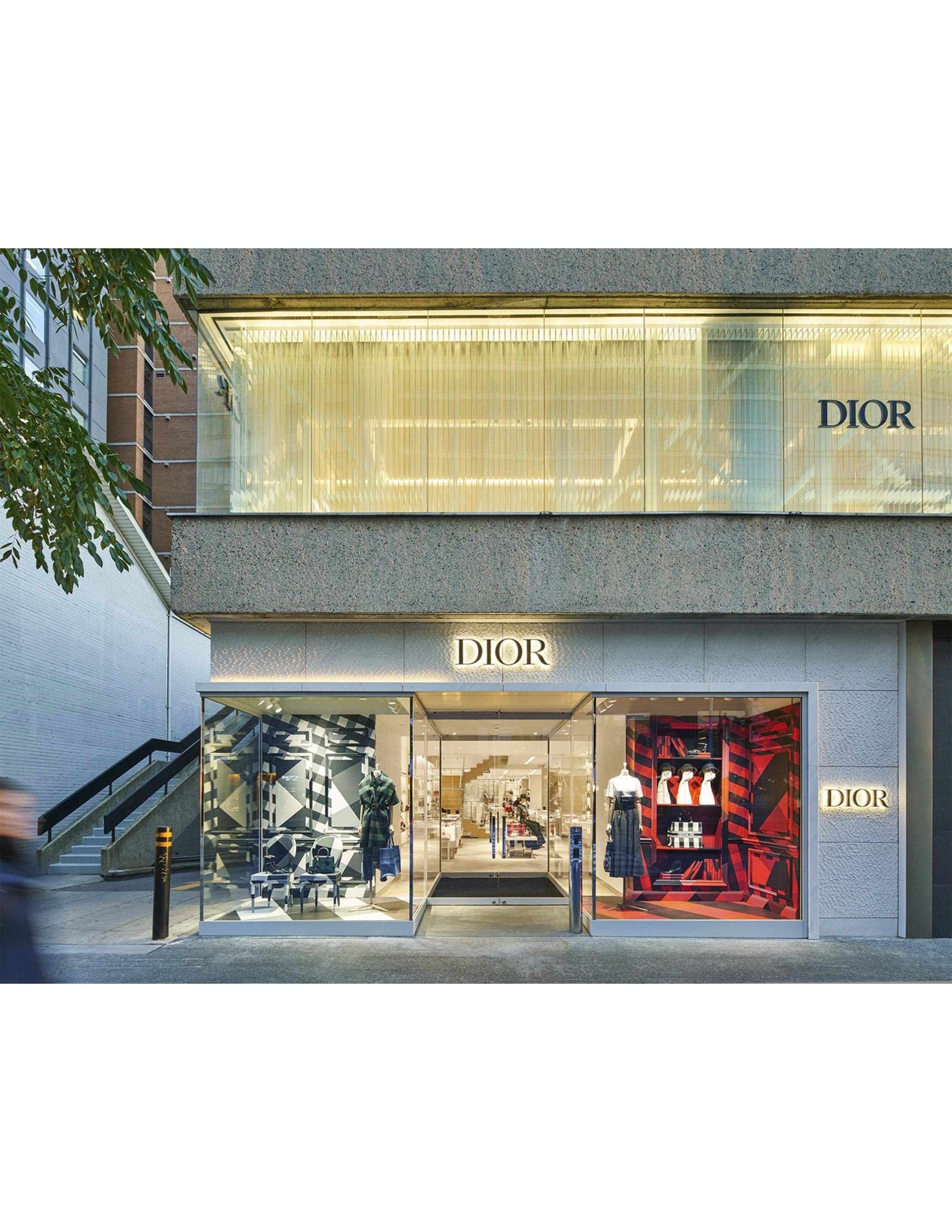


Amid growing U.S. tariff threats, Canadian consumers are increasingly prioritizing local products over imports, reshaping purchasing behaviours.
// Courtesy of CBRE Canada

Thepast five years haven’t been easy for Canadian retailers in their home country. From changing consumer spending habits to shifting demographics and tariff threats more recently, retailers have faced their share of challenges.
But CBRE Vice President Kate Camenzuli, who specializes in multi-market retail expansions, says it’s not all doom and gloom.
“There’s some fear around the unpredictability of the retail market, domestically and internationally,” she acknowledges. “But Canadians are a force to be reckoned with. We continue to see some incredible success stories of Canadian retailers and their growth domestically as well as globally.”
Camenzuli is assisting a number of Canadian retailers with global rollouts. She is working with KOTN, a sustainable clothing company based in Toronto that has expanded to the U.S. and made the jump across the pond into the UK.
“KOTN has a strong brand ethos, an incredible and diverse offering and is fully integrated across its supply chain, production and distribution,” she says. “They understand how to take smart and calculated risks, where to push and pull, and when to do that in order to succeed.”



Camenzuli is also partnering with Executive Vice President Cassie Durand, who is based out of CBRE NYC and specializes in U.S. expansions, on several multi-market accounts. They joined forces to help Toronto jeweller Mejuri expand, with Camenzuli assisting with the Canadian growth strategy and Durand managing transactions globally. They also have a partnership with Sukoshi, a Toronto-based Asian beauty brand, with Durand assisting with U.S. growth and Camenzuli managing global transactions.
The duo recently secured a prime retail space for Vancouver based luggage company MONOS in Manhattan’s SoHo neighbourhood; the store is set to open this summer.
“We were competing against other global brands but MONOS’ phenomenal business model and vision won out,” says Camenzuli. “This is a huge win and shows that Canadian retailers have what it takes to outpace their global peers and get the best real estate with the right partners.”
The global rollouts of KOTN, Mejuri, Sukoshi Mart and MONOS are models for success in challenging times. Camenzuli says these companies are taking a back-to-basics approach with a
strong focus on understanding their data. “They know their business better than anyone. Costs may rise but retailers who understand their customers, know their margins and lean into what makes them great will adapt.”
Partnering with the right advisors like Camenzuli and Durand can also help to ensure successful expansions into new markets. KOTN, Mejuri, Sukoshi and MONOS are working with experts who understand the local markets they’re entering and can secure the best real estate—and navigate tariffs.
“It’s normal to have fear in challenging times but in retail, increasing your store count can be a key factor to growth,” says Camenzuli. “You just have to find the right people to grow with.”
With many companies frozen by uncertainty and tariff fears, Camenzuli believes now is a good time for retailers to make a move, encouraging retail leaders to take calculated risks and stay nimble, as hard times can generate opportunities.
“It’s time for retailers to be bold,” she says. “Global consumers want to support good brands, no matter where they’re from. So if you’re a Canadian retailer with an innovative idea, pursue it. “Because if not now, then when?”
As department stores vanish from Canada’s retail landscape, shopping centres are evolution - one that couldreshape howCanadians experience retail

By Craig Patterson

With the Hudson’s Bay Company now shuttered and all 80 of its stores now closed, the question arises: what comes next for the shopping centres built around these legacy retailers?
Michael Kehoe, Broker/Owner of Fairfield Commercial Real Estate, believes we’re witnessing a positive turning point. “Retailing is always changing and evolving,” he says. “This is a tremendous opportunity for shopping centres to repurpose unproductive space and move on from the department store era.”
Kehoe describes the departure of department store anchors not as a crisis, but as a release. “It takes the shackles off huge swaths of retail space,” he explains. “And that includes the parking fields and surrounding land that were once under restrictive covenants. Landlords finally have freedom to explore new uses for these valuable parcels.” are being forced into a period of rapid

With retail space now freed from anchor tenant agreements, landlords can innovate. Kehoe highlights that the once “sterilized” land tied to department store leases can now be repurposed.
“This is great for retail,” he says. “I welcome it.”
CF Chinook Centre in Calgary exemplifies this transformation. Once home to three department stores—Hudson’s Bay, Saks Fifth Avenue, and Nordstrom—it now finds itself in the middle of an identity shift.
“Chinook is really a cluster of villages,” explains Kehoe. “You have a luxury cluster, an athleisure cluster, a strong food hall—it’s an amalgamation of shopping experiences.” He credits Cadillac Fairview’s strategic merchandising for the mall’s resilience. “They’re masters at drawing traffic to different parts of the mall through clustering and strategic food placements to increase dwell time.” Apple, Lululemon, and other so-called “impact brands” have replaced department stores as major traffic generators. “People will line up around
“...we’re filling those ends with different kinds of uses. Shopping centres have already morphed into mixed-use destinations. We’re seeing more experiential retail, entertainment, dining, and health and wellness tenants.”
- Michael Kehoe, Fairfield Commercial Real Estate
the block for a new iPhone,” says Kehoe. “That’s the draw now.”
The traditional “dumbbell” mall design—department store anchors on each end with small retailers in the middle—emerged in the 1950s. But that model is now being dismantled.
“The dumbbell concept is more relevant than ever—only now, we’re filling those ends with different kinds of uses,” Kehoe notes. “Shopping centres have already morphed into mixed-use destinations. We’re seeing more experiential retail, entertainment, dining, and health and wellness tenants.”
He adds that many malls are preparing for largescale redevelopment. “Some will be densified. Some may see residential or office components added. But it’ll take time—five years or more in many cases.”
Department Store Space: A Slow Rebirth
Repopulating vacated department store space isn’t quick. Kehoe points to Southcentre Mall in Calgary, where a Sears location closed in 2018.
“Only now are we starting to see that space filled,” he says. “And with Hudson’s Bay shuttered, there’s a million square feet in Calgary alone that needs to be repurposed.”
Retailers like IKEA and LEGO are exploring urban formats that could occupy parts of these footprints. “Loblaws moved into Maple Leaf Gardens in Toronto—anything’s possible if we keep an open mind,” he says.
Yet, filling these large spaces amid economic uncertainty won’t be easy. “We’re in a recession,” says Kehoe. “With the tariffs and changing consumer habits, it’s a scorched-earth moment. Only so many dollar stores and fitness chains can go around.”



The liquidation of Hudson’s Bay comes at a challenging time for landlords. Cadillac Fairview, Oxford Properties, and Ivanhoé Cambridge have already weathered losses like Nordstrom’s exit. Many institutional owners are now reconsidering their place in the sector.
“Cadillac spent $11 million building out that Nordstrom store at Chinook,” Kehoe recalls. “Several years later, Nordstrom was gone.” He sees a shift toward more entrepreneurial mall ownership. “These landlords are closer to their assets and more agile. It’s not necessarily a bad thing.”
The Downtown Dilemma
Downtown cores across the country may be hardest hit by Hudson’s Bay’s demise. Flagship stores in Montreal, Vancouver, Calgary, Ottawa, and Victoria are integral to the fabric of those cities.
Kehoe is cautiously optimistic with respect to what happens next. “Yes, it creates short-term uncertainty, but these are incredible urban assets. They’ll be repurposed—perhaps into mixed-use developments, residential units, or even entertainment and cultural spaces.”
Still, he acknowledges the psychological weight. “People are nostalgic. The Bay is where they bought their first suit or appliance. But retail is about staying relevant.”
Despite the company’s retail decline, the emotional connection to Hudson’s Bay runs deep.
“The story of the Hudson’s Bay Company is the story of Canada,” says Kehoe. “They were our first retailers. Indigenous peoples were their first customers. They shaped cities. They laid out street grids.”

In Calgary, Kehoe points to the historic Bay arcade façade—“a unique architectural gem in North America.” In Edmonton, he recalls Fort Edmonton’s roots in the fur trade. “The Bay’s history stretches from the Rocky Mountains to San Francisco.”
The legacy lives on in place names, roads like Anthony Henday Drive, and even in the collective memory of Canadians. “It’s not just a store. It’s part of our national identity.”
For all the disruption, Kehoe is clear-eyed.
“Shopping centres are always evolving. This is just another chapter.”
He notes that premium centres like Yorkdale in Toronto continue to thrive, generating over $2,400 per square foot. “Great malls still perform. But the model is changing.”
As for the Hudson’s Bay space across the country, he believes opportunity outweighs risk. “There’s going to be a gazillion users that come out of the woodwork,” Kehoe says. “It’s actually quite exciting.”
In the end, it’s about adaptation. “This too shall pass,” Kehoe says. “Retail real estate is like a river—it bends, it flows, but it never stops.”




Toronto’s own Carriage Trade boutique recently expanded to an impressive 6,000 square feet with a grand reopening, refreshed design, and launch of a brand-new Canadian designer showcase program // By Craig Patterson
Abeloved mainstay of Toronto’s retail landscape is stepping into a new chapter. Carriage Trade, a high-end women’s fashion boutique located in the Kingsway neighbourhood at 2984 Bloor Street West, has officially unveiled its expanded space, doubling its footprint to 6,000 square feet and ushering in a new era of experiential, service-focused retail.
“This is the next phase of Carriage Trade,” said owner Nori Mirza in an interview following the
boutique’s grand reopening celebration. “We’ve expanded into the adjacent space, completely renovated, and created something that really speaks to who we are now—welcoming, elegant, and very much community-driven.”
Celebrating 62 Years With a Grand Opening Party
To mark the milestone expansion, Carriage Trade hosted a grand reopening event last week, bring-
ing together loyal customers, media, Canadian designers, and community supporters.
“It was our official grand opening—really a thank-you to the people who’ve supported us for decades,” said Mirza. “Some clients brought their daughters and granddaughters. That kind of multi-generational support is what makes this store so special.”
Keeley Malloy, Carriage Trade’s Digital Marketing and Ecommerce Manager, helped coordinate the event, which featured live music from Toronto-based singer Cleopatra Williams, DJ Nick Marshall, and a catered menu curated by Toben featuring all-Canadian cuisine.
“The food was amazing—even if we didn’t get to try much of it because we were working,” joked Mirza.
The expanded Carriage Trade spans two levels, offering a transformed shopping experience that includes more fitting rooms, open sightlines, and beautifully merchandised displays.
“We love it,” said Mirza. “We were a little worried at first because we couldn’t knock down the entire middle wall, but it’s worked out beautifully. Customers aren’t waiting for fitting rooms anymore, and the space feels open and airy. It’s easier to see the merchandise—and even pieces we’ve had for months now look brand new.”
Warmth and accessibility were central to the store’s design ethos. Gold-toned fixtures, walnut wood shelving, and dusty rose accents create an inviting, feminine atmosphere. “It’s not cold or intimidating,” said Mirza. “We wanted the space to feel like a place where anyone can walk in and feel welcome.”
The signature horse-and-carriage logo, reintroduced as part of the rebranding, now appears
throughout the store—from the gold-accented fixtures to the embroidered velvet curtains in the fitting rooms.
Carriage Trade’s expansion also includes a stylish basement level that houses sale items on one side and a soon-to-launch private styling space on the other.
“We’ll be using the room for working with stylists and our VIP clients,” Mirza explained. “It’s multifunctional—we can host events, trunk shows, and pop-ups. It’s beautiful, with high ceilings and the same warm atmosphere as upstairs.”
The design language continues in the lower level, with warm tones and soft lighting that reflect the boutique’s upscale-yet-approachable personality.
A key feature of the boutique’s evolution is its new Canadian Designer Showcase—a rotating
“We’ll
be using the room for working with stylists and our VIP clients. It’s multifunctional-we can host events,trunkshows and pop-ups. It’s beautiful, with high ceilings and the same warm atmosphere as upstairs.”
- Nori Mirza, Carriage Trade

program to spotlight emerging and established homegrown talent.
“We’ve always carried international brands, but now we’re doubling down on Canadian designers,” said Malloy. “We kicked off the showcase with jewelry designer Cynthia and fashion designer Amanda Maria, and the response has been incredible.”
Both designers attended the opening night celebration, engaging with customers and introducing their collections. Amanda Maria’s fall collection was featured as an early trunk show for the occasion, with curated selections expected in-store again for the fall season.
“Our clients were shopping that night,” said Malloy. “They loved meeting the designers and hearing their stories—it really helps to bring the collections to life.”
The plan is to rotate new Canadian designers into the showcase each season. “We want to keep it fresh,” added Malloy. “There’ll be launch parties with each new designer, and we’re continuing to meet with talent from across the country.”
Despite the boutique’s expanded physical footprint, Carriage Trade is not planning to open additional brick-and-mortar locations. Instead, the focus is on expanding the brand’s reach through a robust online strategy.
“Our clients are everywhere, not just in Toronto,” said Mirza. “And even though our store is highly curated and personal, we’ve figured out how to bring that experience online.”
From FaceTime styling appointments to curated deliveries and a 24/7 customer service ethos, the boutique’s digital team has fostered close rela-
tionships with clients across the country.
“Some of our online customers have never set foot in the store,” said Malloy. “But they shop regularly because we treat them the same way we treat in-store clients. It’s about building trust and offering a personalized experience.”
One of Carriage Trade’s most innovative approaches is its weekly live shopping event, hosted every Thursday at 6 p.m. via social media.
“We do seasonal wardrobes, vacation edits, tryons—it’s live and interactive,” said Mirza. “Clients can ask questions, see how things fit, and request what they want to see next week. It’s incredibly engaging.”
The format has been popular with both local and remote clients. “People come in saying, ‘I feel like I already know you,’” Mirza added. “It makes the experience so much more intimate. We’re hugging by the time they leave.”
Mirza and her team are among the few in Canada experimenting with live shopping in such a consistent and personalized way—something more common in international markets like China but still rare domestically.
Staying Rooted in the Kingsway
Carriage Trade’s continued investment in its Kingsway location reflects a belief in the strength of the neighbourhood. “This area is special,” said Mirza. “It’s beautiful, it’s affluent, and there’s a great sense of community. People think of it as being outside Toronto, but we’re very much still in the city.”
While the store serves as a destination for shoppers from across the GTA, it also remains a cornerstone for the local community.

“We’ve been here for over 60 years. We’ve seen generations of women come through these doors,” said Mirza. “And we’ve grown with them. Now their daughters and granddaughters are discovering us too.”
As department stores struggle and e-commerce continues to reshape the retail landscape, Carriage Trade is thriving by doing what it does best: offering genuine, curated service with style.
“We’re not commission-based. We’re not pushy. We’re here to help you find pieces you love and feel good in,” said Mirza. “Nobody needs anything these days. People shop with us because of how we make them feel.”
The newly expanded Carriage Trade is more than just a retail store—it’s a case study in how legacy retailers can modernize without losing their soul. By blending physical warmth, digital access, and a deep understanding of customer care, Mirza and her team are redefining the boutique shopping experience in Canada.
“There’s a shift happening,” said Mirza. “People don’t want cold, sterile stores or overly edited campaigns. They want real connection—and that’s exactly what we’re offering.”
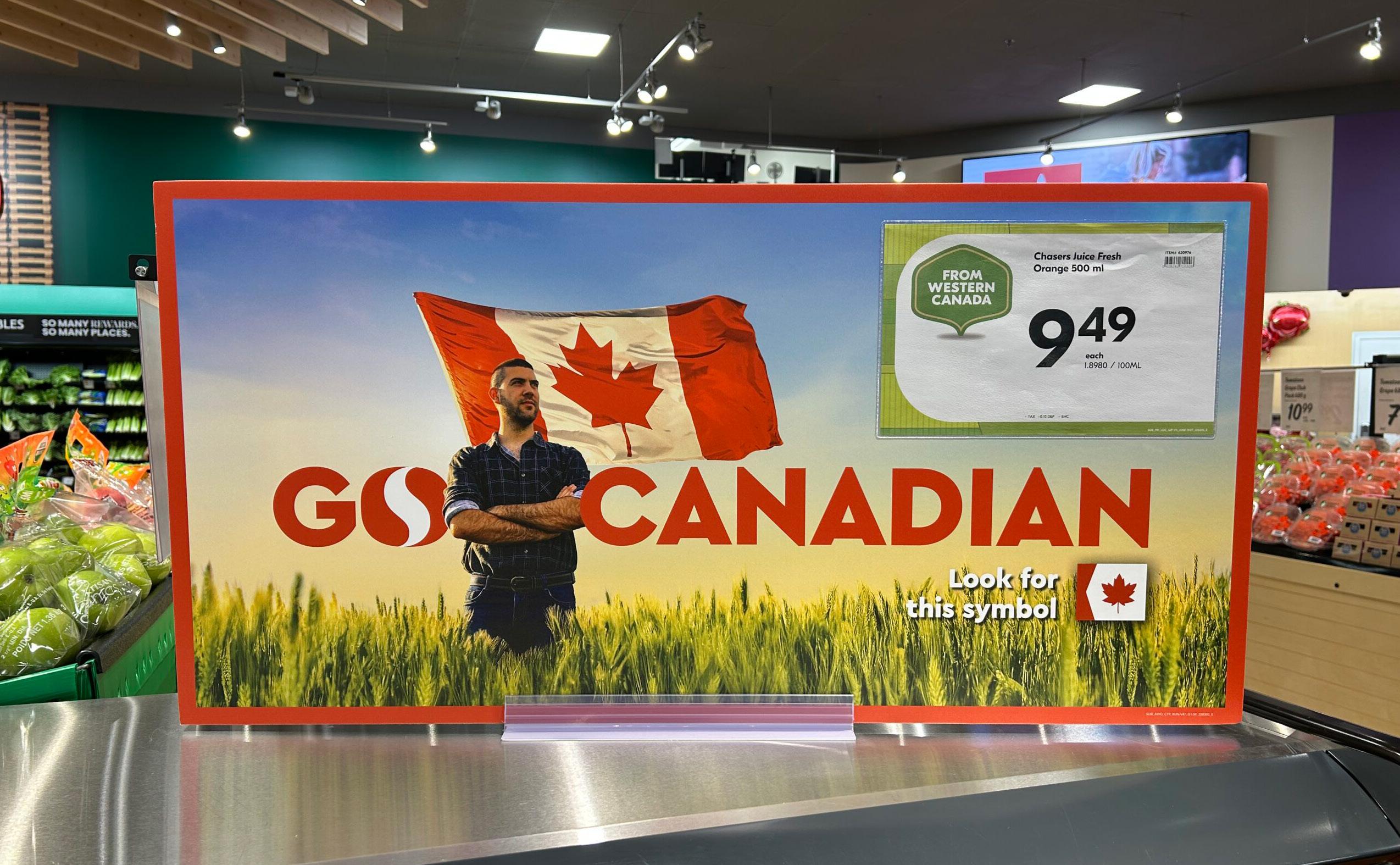
New research from Horizon Media Canada confirms a powerful consumer shift that’s currently taking place toward local loyalty - one that is reshaping purchase behaviour across provinces and generations // By Mario
Toneguzzi
Newresearch from Horizon Media Canada confirms a powerful consumer shift toward local loyalty—one that is reshaping purchase behaviour across provinces and generations.
According to the firm’s latest Finger on the Pulse survey, 83 per cent of Canadians say buying local evokes a sense of national pride, and 71 per cent report being more loyal to Canadian brands in 2025 than they were a year ago.
Conducted in April with a nationally representative sample of more than 1,000 adults, the survey
finds that Canadians are responding to economic uncertainty, rising tariffs and a weaker dollar by making more intentional, values-based choices at checkout, it said.
“This isn’t performative patriotism—it’s a strategic consumer shift,” said Robert Jenkyn, President, Horizon Media Canada. “People are using their dollars to vote for trust, transparency, and Canadian-made value. It’s a loyalty play with real staying power.”
A national turn inward — and a lasting one
The loyalty shift is taking root across the country, but Atlantic Canada (62 per cent), British Columbia (71 per cent) and Ontario (74 per cent) are leading the way. The trend is being reinforced by changes in travel behaviour as well: 67 per cent of Canadians say they’ve adjusted or cancelled trips to the United States due to the weak Canadian dollar, and 59 per cent say they’ve reduced their purchases of U.S. brands altogether, said Horizon.
This is not a short-term reaction. Eighty-five per cent of Canadians say they plan to prioritize Canadian-made products moving forward, with many indicating they will do so even if prices increase. The preference is strongest among Gen X and Boomers, who are most likely to switch away from global brands in response to tariff-related price hikes. But even younger consumers — while more globally open — are looking for authenticity and purpose in the brands they choose, said the report.
“When a brand clearly communicates that it’s Canadian, shoppers perceive it as more credible, more relevant and increasingly more responsible,” said Richard Ivey, Horizon’s EVP, Business Solutions. “That creates real market advantage — and it’s an opportunity brands can’t afford to ignore.”
Messaging, media, and markets:
Horizon said the survey offers clear guidance for CMOs and brand leaders aiming to activate against this wave of values-led loyalty. Canadians respond most strongly to campaigns that emphasize support for Canadian jobs and businesses, the higher quality of Canadian-made products, and the desire for economic independence from global trade instability. Environmental benefits also resonate but rank just behind economic and quality-based messages.
“Where a message is delivered matters, too. Instore promotions (67 per cent) and television
ads (57 per cent) are the most trusted platforms for reinforcing Canadian identity — especially in Ontario and the Prairie provinces, where traditional channels carry outsized influence. In contrast, only 41 per cent of respondents selected digital or social media as ideal channels for this messaging, indicating a renewed consumer trust in mass media when it comes to values-based brand storytelling,” it said.
“The shift is most pronounced in food and beverage, where 82 per cent of Canadians actively seek out Canadian-made products, particularly in Quebec and Atlantic Canada, where local economic ties run deep. However, momentum is also growing in personal care, home goods and fashion, especially in British Columbia and Saskatchewan — suggesting strong portfolio expansion opportunities for brands that can authentically reinforce their Canadian ties.”
While Millennials and Gen Z are less influenced by patriotic appeals alone, they remain highly responsive to brands that demonstrate transparency, sustainable practices, and price fairness. These younger cohorts represent both a challenge and an opportunity: they demand more, but they are also more willing to engage with global brands — if those brands can clearly articulate their purpose and impact in Canada, explained Horizon.
“As Canadians marked their national holiday, this research underscores the urgency — and the upside — of embracing Brand Canada. It’s not a niche play or a seasonal slogan. It’s a powerful, durable driver of loyalty, especially in a market defined by rising consumer scrutiny and spending caution,” it said.
“There’s never been a more important time to reinforce Brand Canada,” added Jenkyn. “National pride isn’t just symbolic—it’s showing up in shopping carts, credit card statements and the companies people choose to support. The marketers who take that seriously—not as a trend, but as a cultural signal—will be the ones who win.”

Laura Canada celebrates 95 years of growth and success with new store openings, a national ad campaign, and digital innovation. Vice President Josh Fisher shares his insights concerning the brand’s future // By Craig Patterson
Canadian fashion retailer Laura Canada is celebrating a remarkable milestone: 95 years in business. From a single boutique on Montreal’s St. Hubert Street in 1930 to more than 140 stores across the country today, the family-owned business has become a household name for women’s fashion in Canada. As the company celebrates its legacy, it is also making bold moves toward the future—with store expansions, enhanced digital
innovation, and an impressive national Summer campaign that proudly leans into its Canadian identity.
“Our model has always centred on meaningful relationships with customers and employees,” explains Josh Fisher, Senior Vice President at Laura Canada and great-grandson of the company’s Founder Laura Wolstein. “That focus has been
key to our resilience, sustaining us long before, through and beyond the pandemic.”
Founded in 1930 by Laura Wolstein, a trailblazer for female entrepreneurs, the company opened its first store in Montreal at a time when women’s rights were still evolving—particularly in Quebec, where women only gained the right to vote provincially in 1940. Her approach, which focused on high-quality fashion and personalized service, struck a chord with women who were seeking both style and confidence. Building on this legacy, the brand continues to foster a sense of community by creating welcoming spaces where women feel seen, supported, and connected, both in-store and beyond.
That customer-centric ethos continues to define the brand nearly a century later. “Fashion is a universal language that unites us,” Fisher explained. “Our stores offer constant reminders of the power it has to create shared connection, joy and belonging.”
Despite a challenging retail environment, Laura Canada has not only survived—it has thrived. The company operates over 140 stores across Canada under the Laura and Melanie Lyne banners, employing nearly 2,000 people and serving more than 12 million customers.
“It means the brands have continued to resonate deeply with our customers across the country,” said Fisher. “Many women get very frustrated trying to put outfits together, and find the typical shopping experience too cold and impersonal. By empowering customers to understand how to dress in ways that flatter them, our style advisors play a huge role in animating our stores.”
While other retailers are scaling back, Laura Canada is expanding. The company recently
opened a Laura store at Orchard Park in Kelowna, B.C., and will soon open four more locations, including at Emerald Hills in Sherwood Park, just outside Edmonton. Two additional stores—a Laura and a Melanie Lyne—are also set to open at Kingsway Mall in Edmonton, which Fisher noted has significantly improved its tenant mix.
“We’ve just opened Laura at Orchard Park in Kelowna, where we knew we had the customer demand,” he added. “And the store is off to a terrific start, exceeding our projections.”
The company is also undertaking renovations, including an update at Bayshore in Ottawa, where Laura has operated for nearly 50 years. Meanwhile, a redesigned Melanie Lyne concept has rolled out at CF Fairview Mall (Toronto), CF Market Mall (Calgary), and Mapleview Shopping Centre (Burlington).
“Many women get very frustrated trying to put outfits together, and find the typical shopping experience too cold and impersonal. By empowering customers to understand how to dress in ways that flatter them, our style advisors play a huge role in animating our stores.”
- Josh Fisher, Laura Canada


“Next year is shaping up to be busy as well, so we’re continuously optimizing our locations across Canada,” Fisher said.
In May, Laura launched a new national broadcast advertising campaign, its first to air on television. Originally developed as a digital initiative, the campaign evolved into a full-scale patriotic message timed with the NHL Playoffs and amid geopolitical tensions that stirred national pride.
“When the trade war broke out, we saw how emotional and patriotic customers were feeling, and at the same time there was excitement among our customers and employees around six Canadian teams making the NHL playoffs,” said Fisher. “Everyone was so put off by some of the political narrative, and we felt that this was a way to remind Canadians that there is so much to be proud of when we reflect on the uniqueness of the Canadian experience.”
The campaign aired during high-profile moments like NHL games and has since garnered over a million views on YouTube, in addition to widespread broadcast exposure.
“Employees and customers were very proud of the message,” he added.
Though deeply invested in physical retail, Laura Canada has also embraced e-commerce and omnichannel strategies. Rather than viewing digital and in-store as competing forces, Fisher sees them as complementary.
“Stores remain a much more effective way for new customers to discover the brand, for inspiration and exploration, for interacting with style advisors,” he said. “There are times between stores visits when you want to check for new arrivals or get quick inspiration for how to style
a top you bought, and a minute or two on your smartphone suffices.”
This summer, the company will roll out Shopify’s Point of Sale and payments system in stores, unifying its physical and digital retail ecosystems. It’s part of an investment in seamless, flexible shopping for customers, with features such as BOPIS (buy online, pick up in store), ship-from-store, online returns in-store, and real-time inventory visibility.
“Our customers aren’t Gen-Z who grew up with technology,” Fisher explained. “So we prioritize innovations that empower our teams to improve the shopping experience, rather than pushing customers to be early adopters of new tech.”
Laura Canada has also invested in clienteling tools that allow style advisors to maintain relationships with customers between visits, and has introduced personalized recommendations via its e-commerce platform and marketing automation.
“Personalization takes different forms,” Fisher said. “But the best form is when customers work one-on-one with a style adviser who understands what flatters her and helps her evolve her wardrobe with each new collection.”
Informed by Customer Insight
Customer feedback is at the heart of Laura’s merchandising and marketing strategies. The company regularly conducts focus groups, gathers digital survey data, and relies heavily on insights from in-store teams.
“Many of our style advisers started as customers,” Fisher said. “They felt so empowered that they decided to join Laura and help other women learn how to dress in a way that flatters them.”
Demographic data, ecommerce analytics, and real estate partnerships also play a critical role in

expansion decisions. “We analyze demographic databases for matches with our CRM data, track ecommerce orders and website activity, seek advice from our store operations teams, work with our landlords, and are guided by our real estate advisors at Oberfeld Snowcap,” said Fisher.
Like many other retailers, Laura Canada had to adapt quickly during the pandemic. But its long-standing focus on relationships and longterm value gave it a head start on navigating the uncertainty.
“The pandemic demanded agility across all industries, but it also reinforced that sustained retail success still hinges on long term thinking,” explains Fisher. “The demise of The Bay is sad for Canadians who have fond memories working or shopping there, but it’s been sad for a while, ever since its leadership shifted focus to short term wins rather than lasting growth. Now there’s an exciting opportunity for the landlords to improve the tenant mix and drive more traffic to their properties. As a family owned and operated business, we’re able to lead with a long-term perspective.”
In contrast, he points to the struggles of once-dominant Canadian retailers like Hudson’s Bay.
“It’s been sad for a while, ever since its leadership shifted focus to short-term wins rather than lasting growth,” he explains. “Now there’s an exciting opportunity for the landlords to improve the tenant mix and drive more traffic to their properties.”
Laura Canada’s story is one of resilience, reinvention, and continued relevance. From its roots in a single Montreal boutique to a national presence in malls across nine Canadian provinces, the

brand has remained committed to empowering Canadian women—through fashion that flatters, service that connects, and strategies that adapt to an ever-changing retail landscape and evolving consumer tastes.
And, as the company steadily approaches its 100th year, Laura Canada shows no signs of slowing down.
“We remain focused on building enduring value for the company and those who drive our success: our employees and customers,” Fisher said. “We’ve never closed a store due to ecommerce growth. In fact, when we open a store in a new market, online sales in that market increase.”
In a volatile retail environment, that kind of confidence is rare—and perhaps exactly what has kept Laura Canada thriving for 95 years.

Craig Patterson

U.S. President Donald Trump’s ongoing threats of new tariffs on Canadian goods, Canadian consumers are doubling down on their commitment to buying homegrown products. The Canadian government has responded with retaliatory tariffs on $30 billion worth of American imports, further fueling the momentum behind the “Buy Canadian” movement.
But with a surge in demand for locally made goods, a crucial question arises: What does it truly mean when a product carries a “Product of Canada” or “Made in Canada” label? Can consumers trust a Maple Leaf symbol to guarantee a product’s Canadian origins? Understanding the nuances of these labels is essential for shoppers aiming to support domestic industry and avoid misleading claims.
The Canadian Food Inspection Agency (CFIA) provides clear guidelines on what constitutes a “Product of Canada.” This label signifies that all or nearly all the food, processing, and labour involved in making the product are Canadian.

While small amounts of imported ingredients, such as spices or additives, may be present, the vast majority of the product’s composition must originate from Canada.
For non-food items, the Competition Bureau states that the “Product of Canada” designation applies only when at least 98% of the total costs of production or manufacturing have been incurred in Canada. This ensures that the label is reserved for products that are overwhelmingly Canadian in origin.
The “Made in Canada” label carries a different set of criteria. According to the CFIA, this designation applies when the last significant transformation of the product occurs in Canada. For example, if raw ingredients from multiple sources are combined to create a finished food product—such as pizza made from imported cheese, dough, and sauce—the final assembly qualifies as a substantial transformation.
For non-food items, the Competition Bureau requires that at least 51% of production or manufacturing costs be incurred in Canada for a product to carry the “Made in Canada” label. Further, businesses must disclose whether the product is made in Canada from imported components, domestic ingredients, or a combination.
The term “Canadian” is regulated in a manner similar to “Product of Canada.” When a food item is labeled as “Canadian,” it means that all or virtually all major ingredients, processing, and labour involved in its production are Canadian. If a frozen lasagna is labeled as “Canadian,” consumers can be assured that it meets the strict criteria for “Product of Canada.”
Similarly, when a package states “Canadian Cheddar Cheese,” the cheese itself must be made entirely from Canadian ingredients and undergo
processing within the country.
100% Canadian: The Gold Standard
For food or ingredients to bear the “100% Canadian” claim, the CFIA mandates that every element of the product, including processing and labour, be entirely Canadian. This label leaves no room for imported components, making it the most transparent designation for consumers seeking purely Canadian products.
The Maple Leaf Symbol: A Misleading Marker?
While the iconic Maple Leaf is often used to signify Canadian products, its presence on packaging does not mean that a product is wholly or even partially Canadian. The CFIA recommends that companies include a domestic content statement alongside the Maple Leaf to clarify the product’s origin, but compliance is not mandatory. As a result, shoppers must look beyond the symbol and examine product labels carefully.
Produced or Manufactured in Canada: The Competition Bureau considers phrases like “Produced in Canada” and “Manufactured in Canada” to align with the “Made in Canada” designation, meaning that products bearing these labels must comply with the same criteria of substantial transformation and cost thresholds.
Local Products: When a company advertises a product as “local,” CFIA regulations require that it be produced in the province or territory where it is sold or within 50 km of the originating region if crossing provincial borders. This ensures that consumers purchasing locally branded goods are genuinely supporting nearby businesses.
Industry-Specific Labels: Dairy, Meat, and Seafood
The Blue Cow Logo: In the dairy aisle, consumers
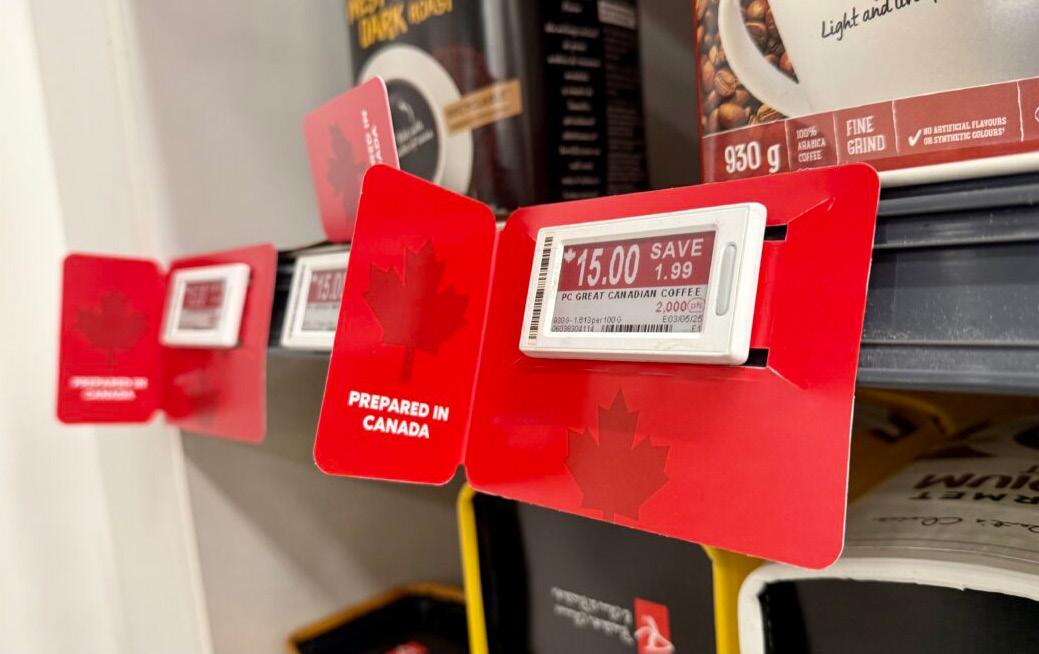
may notice the blue cow logo, which is overseen by the Dairy Farmers of Canada. This mark signifies that the product is made entirely with Canadian milk and milk ingredients, ensuring its authenticity.
Meat and Poultry: Meat products labeled as “Product of Canada” must come from animals that were raised and slaughtered in Canada. For feeder cattle, animals must have spent at least 60 days in Canada before being processed domestically.
Fish and Seafood: For wild fish and seafood to carry the “Product of Canada” label, they must be caught by Canadian vessels in domestic waters and processed in Canada using Canadian ingredients. In the case of farmed seafood, both the farm and processing facility must be located within Canada.
Dairy and Eggs: Eggs and dairy products from animals raised in Canada qualify for “Product of
Canada” status, even if the livestock was originally imported, provided the eggs were laid and milk was collected in Canada.
The Bottom Line: Navigating “Buy Canadian” Claims
As Canadians increasingly turn to homegrown goods in response to trade tensions, understanding product labeling is more critical than ever.
While terms like “Product of Canada” and “Made in Canada” offer guidance, shoppers should remain vigilant in verifying a product’s true origins by reading the fine print.
With transparency varying across industries, consumer awareness remains the best tool for ensuring that purchases genuinely support the Canadian economy. The “Buy Canadian” movement is stronger than ever, but a well-informed approach is key to making meaningful contributions to local businesses and manufacturers.
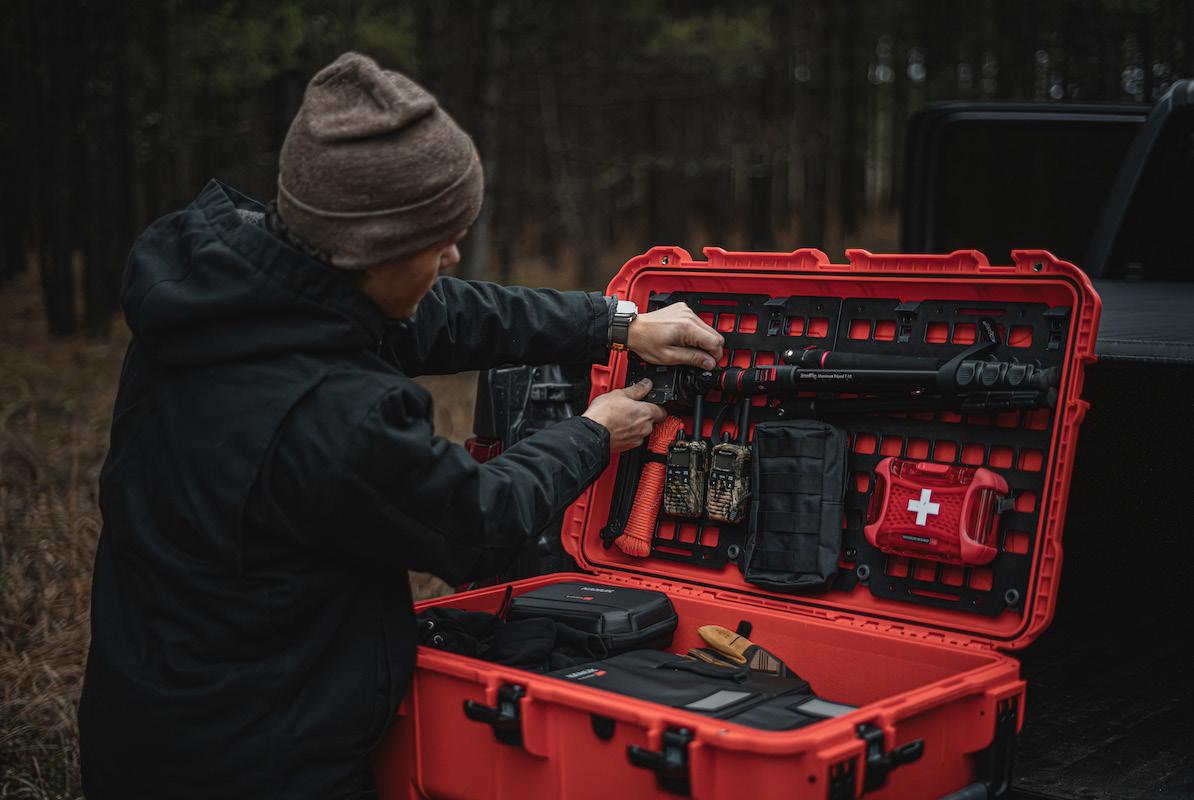
Quebec-based manufacturer of protective cases expands globally with new products, eco-friendly innovations and a strong Canadian identity, aiming to become the leader in outdoor gear
// By Craig Patterson
Founded in 2008, Nanuk has grown from a small Quebec-based manufacturer into a globally recognized brand specializing in ultra-durable protective cases. The company, originally known as Plasticase, was acquired by Walter Capital in 2018 and has since undergone a major transformation.
“When we started we were a small enterprise with about 54 employees,” said José Chagnon, CEO of Nanuk. “Since then, we’ve tripled in size
- growing revenue, staff, footprint, everything about the company.”
Now operating under the new name Nanuk Gear Protection, the company aims to become a global lifestyle brand known for premium-quality cases and accessories—akin to what Yeti has become for coolers and outdoor gear.
“Our ambition is to become the Yeti of Canada,” Chagnon said. “We’re not just a case manufactur-
er anymore—we’re building a lifestyle brand.”
Nanuk’s growth has been fuelled primarily by aggressive expansion in both product development and distribution channels. As a result, the company now does business in Europe, the U.S., and beyond.
“In 2018, we acquired a distributor in the Netherlands. Since then, our revenue in Europe has increased twelvefold,” Chagnon noted. “We also created a U.S. entity and launched our own e-commerce platform in 2020, just as the pandemic hit.”
During the COVID-19 pandemic, the company pivoted in order to meet urgent needs in the medical sector, providing protective cases for sensitive equipment like ventilators. That move helped Nanuk not only weather the crisis but accelerate growth.
With commercial sales now accounting for 60–65% of its business, Nanuk is looking to increase consumer-facing sales. Its new backpacks, trail gear, and first aid kits are designed to broaden the brand’s appeal and reach.
Nanuk has also been nurturing a robust online community, particularly in the photography and videography markets.
“We’ve been building up our community for years—on Instagram we have over 40,000 followers,” said Chagnon. “It’s not bad for a Quebec-based company.”
The brand’s cases are popular among photographers, drone users, and broadcasters, often sold through well-known retailers like B&H Photo in New York and Amazon, as well as Toronto-based retailers like Henry’s.
Championing Canadian Manufacturing
Manufacturing locally has remained a core part of Nanuk’s identity, even when global competition pressures companies to move production overseas.
“Yes, it can be more expensive than China,” Chagnon admitted, “but we have great partnerships and innovation here in Canada. Our products are molded and assembled locally, and 90 per cent of our raw materials are sourced from Quebec and the rest of Canada.”
One of Nanuk’s proudest achievements is the development of its NANUK R product line, which uses post-consumer recycled plastic. This initiative—developed in partnership with Montreal-based LAVAN Group—cut the carbon footprint of each case by 50% on average.
“We’re the only company in the world producing protective cases with this type of post-consumer
“Yes, it can be more expensive than China, but we have great partnerships and innovation here in Canada. Our products are molded and assembled locally, and 90 per cent or our raw materials are sourced from Quebec and the rest of Canada.”
- Jose Chagnon, Nanuk

recycled material,” said Chagnon. “That innovation was only possible through local partnerships.”
Nanuk is also pushing for more inter-business collaboration in Canada to combat rising costs and improve productivity.
“If I’m shipping a 20-foot container to Australia and my neighbour is shipping another, we could combine shipments and split the cost,” Chagnon explained. “There’s so much potential in cooperative logistics.”
Chagnon is advocating for these kinds of solutions through his involvement in Quebec’s QG100 network—a group of mid-to-large exporters that share best practices.
“In Canada, we provide better living conditions for employees, and that has a cost. We need to
collaborate more to remain competitive.” Navigating Trade Uncertainty and Tariff Risks
One of Nanuk’s biggest challenges now is dealing with the looming threat of tariffs from the United States, where 60% of the company’s business originates.
“We’re preparing for the worst,” Chagnon said. “What happens if a permanent 25% tariff is imposed? We’re reviewing everything—corporate structure, spending, investments.”
Despite the threat, Nanuk has decided not to pass increased costs onto its U.S. customers.
“It wouldn’t be fair. These are partnerships we’ve built over 15 years. We’re going to honour our contracts and keep pricing stable,” he said.
To mitigate risk, the company is diversifying into Latin America, Europe, and Japan. “We entered Japan in May to meet with potential distributors.

It’s a huge market for photo and video.”
Eyeing the Canadian Market
Although based in Quebec, Nanuk still sees untapped potential at home. With many Canadian retailers still favouring U.S.-based protective case brands, Chagnon is pushing for more local representation.
“We’re a Canadian manufacturer, but our competitors dominate the Canadian market,” he said. “That’s something we’re working hard to change.”
Retailers like SAIL and Canadian Tire are starting to take notice. New collaborations are launching in April, including first aid kits developed with local suppliers and the new Trail Gear Connect Case Collection aimed at outdoor enthusiasts.
Nanuk is entering new verticals with confidence. Its recently launched EDC (Everyday Carry) backpack line is made in collaboration with a Colorado-based design firm and features durable, stylish designs with high-quality components like YKK zippers and RFID-blocking pockets.
“We’ve designed five sizes and are launching three this year,” said Chagnon. “It’s timeless, not trendy—it’s built to last.”
Other upcoming products include rifle cases, mission-critical transport gear, and expanded trail and first aid kits.
Nanuk is also in talks with Costco, Academy Sports, Bass Pro Shops, and other major U.S. retailers.
“Our products are designed with durability, function, and elegance,” Chagnon explained. “When people touch and feel them, we win every time.”
Leading with Values and Long-Term Vision
At the heart of Nanuk’s business is a strong sense of responsibility—to employees, partners, and the environment.
“We have to preserve our values, even when times are tough,” said Chagnon. “We provide good jobs and support local suppliers. I’d encourage every business to look at where they’re sourcing from, and whether they can go local.”
Looking ahead, Nanuk has two clear goals: to achieve net-zero carbon emissions and to solidify its place as Canada’s go-to lifestyle brand for outdoor and protective gear.
“We want to become carbon neutral, and we want to become the Yeti of Canada,” Chagnon said. “That’s our mission—and we’re just getting started.”

Toronto’s retail landscape has seen countless changes over the course of the past few decades, but few businesses have demonstrated the resilience and community focus of upscale women’s retailer Options for Her // By Shelby Hautala
Founded in 1979, the multi-brand fashion store has stood the test of time by offering a curated selection of clothing and accessories paired with personalized service. The boutique, led by David Seligman and his wife, Elana Seligman, is celebrating its 45th anniversary this year.
With locations at 163 Cumberland Street in Yorkville and within the TD Centre in Toronto’s Financial District, Options for Her has become synonymous with quality, style, and a customer-first philosophy.
From Humble Beginnings to Toronto Staple
“Our journey began with Edna Schwartz, a renowned retailer on Bloor Street,” explains David Seligman, the founder and President of Options for Her. “We took over her business in the late ’70s and eventually transitioned to focus solely on upscale women’s fashion under the Options for Her banner.”
The Yorkville store has been a cornerstone of the business for 18 years, housed in a boutique-sized
1,200-square-foot space that feels more like an intimate living room than a traditional retail environment. Meanwhile, the 2,100 square foot Financial District store caters to professional women with a more mission-driven shopping experience.
“In Yorkville, customers often spend hours in the store, socializing and exploring our collections. Downtown, it’s more about finding the perfect suit or outfit for a presentation or meeting,” Seligman says.
What sets Options for Her apart is its focus on relationships over sales. “Our philosophy has always been about building connections,” says Seligman. “It’s not about making every sale; it’s about ensuring every customer feels at home. Our customers come to chat, have a coffee, and even make new friends.”
This approach extends to the staff, many of whom have been with the company for over 20 years. “We’re a family,” adds Seligman. “Our team loves what they do, from designing window displays to helping customers build their dream wardrobes.”
Seligman emphasizes this point: “When someone walks into our store, they’re not just another customer. We take the time to get to know their preferences, their lives, and even their families.”
The warmth of the store’s environment is often likened to a living room. “It’s a space where customers feel comfortable. They’re not just shopping; they’re building relationships,” he adds.
Options for Her offers a thoughtfully curated range of brands, including Marc Cain, Cambio, Marie Saint Pierre, Sarah Pacini, Circolo, Jenny Bird, Gerry Weber, and Sosken. Each brand is
chosen to reflect the boutique’s ethos of timeless, elegant style.
“We specialize in separates now,” explains Seligman. “Customers want versatility—like a Cambio pant paired with a Circolo jacket. It’s about creating outfits that are both comfortable and sophisticated.”
He adds, “We’ve always believed in offering quality over quantity. Each piece in our store has been handpicked for its craftsmanship and design.” Seligman notes that the store’s focus on separates aligns with modern customer preferences. “People want pieces that fit into their lifestyle, whether it’s for work, social events, or casual outings,” he says.
Adapting to Changing Times
While the Financial District location faced challenges during the pandemic due to reduced
“We’ve always believed
in offering quality over quantity. Each piece in our store has been handpicked for its craftsmanship and design. People want pieces that fit into their lifestyle, whether it’s for work, social events, or casual outings.”
-
David Seligman, Options for Her

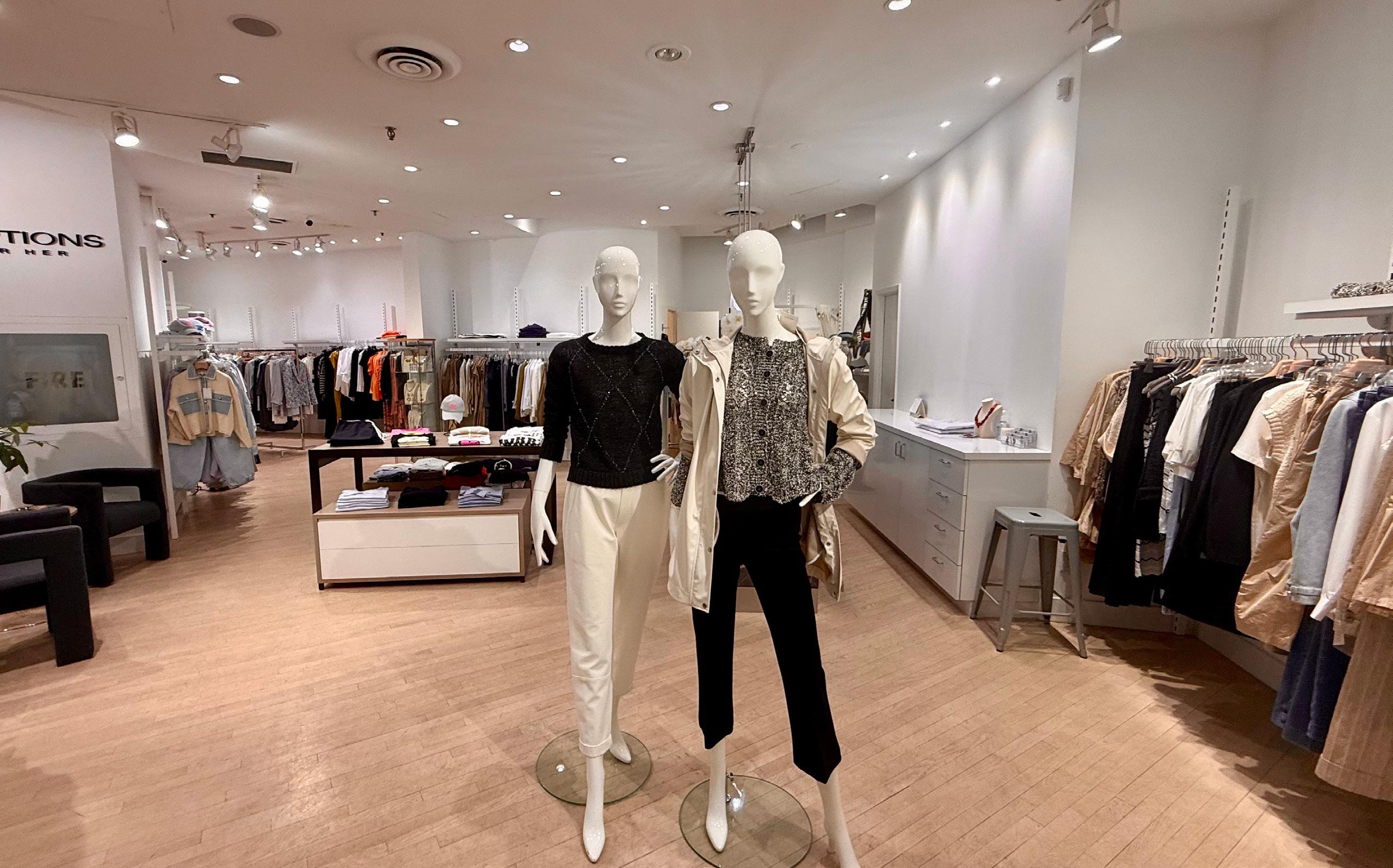
office foot traffic, Yorkville has continued to thrive. “The Yorkville clientele isn’t as affected by economic shifts,” says Seligman. “We see a lot of repeat customers and word-of-mouth referrals. It’s a testament to the strong relationships we’ve built.”
Seligman also notes a shift in fashion preferences post-pandemic. “Our downtown customers are now looking for standout pieces they can mix and match. It’s a shift from the traditional headto-toe suit.”
In the Financial District, customers are often time-strapped professionals seeking quick, high-quality solutions. “It’s a different dynamic,” Seligman explains. “They come in on a mission, and we’re here to help them accomplish it efficiently.”
Beyond its product offerings, Options for Her has also cultivated a sense of community among its clientele. The boutique’s Yorkville location is particularly known for its warm, welcoming atmosphere.
“People often say it feels like they’re shopping in someone’s living room,” Seligman shares. “We’ve become a meeting place where customers connect with friends, share stories, and create lasting memories.”
The social aspect extends beyond customers.
“Our staff enjoys designing window displays and playing with the merchandise. It’s a creative outlet that reflects their passion for fashion,” David explains.
This community-driven approach has been instrumental in the store’s success. “We hear all the time, ‘How have I never known about you?’ when new customers discover us. Word-of-mouth has been our strongest marketing tool,” Seligman adds.

The journey from Edna Schwartz to Options for Her’s current iteration is a story of adaptation and foresight.
“When we moved to Cumberland, we embraced the boutique model because it allowed us to offer a more personalized experience,” Seligman says.
He notes how the business has adapted over decades to meet the evolving retail landscape.
“From the days of a bustling Bloor Street store to the more intimate spaces in Yorkville, we’ve adjusted to ensure our customers feel connected to us”.
Over the past 45 years, Options for Her has weathered economic downturns, changing fashion trends, and even a pandemic, and has managed to emerge stronger than ever before. Its success lies not just in the luxury brands it carries but in the relationships it has nurtured along the way.
As Seligman puts it: “Good things come in small packages. We may not have the visibility of a Louis Vuitton, but we have something even better—customers who trust us and feel at home here.”

// By Craig Patterson

MichelGolbert, President of Pajar Canada, understands the complexities of global trade and manufacturing better than most. As the head of one of Canada’s last remaining footwear manufacturers, Golbert has firsthand experience dealing with the shifting landscape of international tariffs, supply chain disruptions, and domestic production challenges. With potential new tariffs looming, Pajar is facing an evolving economic landscape that could significantly impact its business and the broader Canadian retail industry.
“We have one of the last factories left in Canada,” says Golbert. “A 25% tariff hasn’t been imposed yet, but it seems inevitable. If that happens, it will definitely impact how we operate.”
Pajar’s operations are globally diversified, with about 95% of its production occurring in Europe and Asia. “If tariffs come into play, we’ll be on the same playing field as everyone else,” Golbert explains. “If China gets hit with a 10% tariff, then Nike, Steve Madden, and other brands will face the same increase—unless they know a loophole that we don’t.”

Despite this, Golbert notes that any additional costs will inevitably affect both businesses and consumers. “We’ll do our best to absorb some of the costs, but at the end of the day, consumers will also feel the impact,” he says. “Prices in the U.S. will go up, and that could influence demand for Canadian goods.”
While Pajar maintains a significant global supply chain, it continues to manufacture a portion of its high-end sheepskin boots in Canada. “Our factory in Montreal, on the Plateau, is the original factory my grandfather started in 1963,” Golbert explains. “We employ about 70 workers and produce roughly 150 pairs of boots per day, which retail between $400 and $600. These are sold in premium retailers like Holt Renfrew, Harry Rosen, Browns, Nordstrom, and Saks Fifth Avenue.” However, sustaining domestic production has become increasingly difficult due to the decline of local suppliers.
“Back in the day, everything was produced and
“We just returned from the Domincan Republic to assess new factory options for Fall 2026. We’re also expanding in Brazil. It’s crucial to diversify because today it’s China facing tariffs, but tomorrow it could be Europe.”
- Michel Golbert, Pajar Canada
sourced in Canada. Now, all the small suppliers who provided eyelets, leathers, and other materials are gone,” says Golbert. “We try our best to buy local—our boxes are made in Montreal, and we source YKK zippers locally—but much of what we use comes from Italy and other parts of Europe.”
The U.S. Market and the De Minimis Rule Change
With roughly 50% of Pajar’s sales generated in the United States, any changes to trade policies can have a significant effect on the company’s bottom line. One particularly concerning development is the potential elimination of the U.S. de minimis threshold, which currently allows goods under $800 to enter duty-free.
“That would be way worse than the 25% tariff,” Golbert states. “We have a robust e-commerce business that ships directly from Canada. If de minimis is eliminated, we’ll have to start shipping through a third-party warehouse in the U.S., which increases costs and reduces control.”
Golbert points out that the impact would extend far beyond Pajar. “Millions of packages move across the border daily under this rule. If it changes, not only will Canadian businesses suffer, but American consumers will face higher prices as well.”
With increasing uncertainty around trade policies, many companies—including Pajar—are exploring alternative manufacturing options.
“We just returned from the Dominican Republic to assess new factory options for Fall 2026,” Golbert reveals. “We’re also expanding in Brazil. It’s crucial to diversify because today it’s China facing tariffs, but tomorrow it could be Europe.” However, shifting production isn’t an easy solution. “There’s always a learning curve when moving to a new country,” Golbert says. “We have to ensure factories meet quality standards, ship on

time, and comply with major retailers’ requirements. It’s risky and takes time.”
Despite these challenges, Pajar continues to grow. The company recently acquired Cougar Boots, a Canadian brand known for its winter footwear. “The acquisition has been fantastic,” says Golbert. “Cougar is doing exceptionally well in Canada, and our U.S. distributor has helped us get into all the major retailers we targeted.”
Looking ahead, Pajar plans to expand the Cougar brand. “For Fall 2026, we’re introducing a men’s line—something Cougar hasn’t had in years. We’re also exploring new product categories like outerwear, socks, and underwear, similar to what we’ve done with Pajar.”
Supporting Canadian Manufacturing and National Identity
While global trade dynamics remain uncertain, Pajar remains committed to its Canadian roots. “We’re pushing our Made in Canada products to Canadian retailers, and they’re responding
positively,” Golbert says. “Now, more than ever, there’s a renewed sense of pride in Canadian-made goods.”
Pajar’s branding has long emphasized its Canadian heritage, something Golbert believes resonates with consumers worldwide. “Our logo features the Canadian flag. To people in Europe and the U.S., that represents quality, expertise in winter wear, and a country known for peace and wilderness. That’s a huge selling point.”
As trade policies evolve, Golbert remains optimistic about Canada’s future in the global market. “Short-term, these changes will sting, but long-term, they could make Canada stronger. We need to become more independent and sell our products globally—not just to the U.S.”
Despite the challenges ahead, Pajar is poised to continue its growth, adapting to shifting market conditions while staying true to its Canadian heritage. “We’re prepared to pivot quickly,” Golbert says. “It’s a crazy time, but we’ll navigate it like we always have.”


‘This is J’ Marks 22 Years
// By Craig Patterson

For over two decades, This Is J has been a proud example of Canadian entrepreneurship—small, independent, and entirely locally produced. Founded in 2003 by Jaimie Harris, the Toronto-based brand has evolved from a university side hustle into a well-loved sleepwear and loungewear company, renowned for its ultra-soft, Canadian-made Bamboo Jammers. But as the brand marks its 22th anniversary, a new challenge looms: the impact of proposed U.S. tariffs on Canadian goods.
With the growing complexity of global trade and rising production costs, Harris remains steadfast in her commitment to keeping This Is J’s production in Canada, despite the financial pressures.
“I hope that we don’t get lost in the shuffle of this trade war,” says Harris. “Small businesses have been able to grow because of trade policies that have allowed us to thrive. To take that away is going to be a big setback.”
From Halifax to Toronto: The Birth of This Is J Like many great entrepreneurial stories, This Is J started with a simple need. While studying in Halifax, Harris designed her own headbands to keep her hair out of her face. One day, while shopping, a store owner asked if she sold

them. “I said yes,” Harris recalls with a laugh, “even though I didn’t at the time.” That moment sparked the beginning of a business that would later expand into loungewear and sleepwear, built around the idea of blending fashion with function.
“Back then, you either wore sweatpants or work clothes—there was no in-between,” says Harris. “I wanted something that felt like a second skin but still looked good.”
From the start, Harris was determined to manufacture in Canada, despite the challenges. She worked closely with mills in Montreal and Toronto to develop the ultra-soft fabric that would define Bamboo Jammers, a line that has now become a customer favourite.
“Our fabric is moisture-wicking, super soft, and can go straight into the washer and dryer,” says
“It took years to to develop something this high quality, and we’ve stuck with the same mill for a long time. They believed in our vision. Our entire supply chain is hyper-local. It’s not always the easiest or the cheapest way, but it’s the right way for us.”
- Jaimie Harris, This is J
Harris. “It took years to develop something this high quality, and we’ve stuck with the same mill for a long time. They believed in our vision.” Beyond textiles, Harris ensures that everything from the labels to the packaging is made in Canada. “Our entire supply chain is hyper-local,” she says. “It’s not always the easiest or the cheapest way, but it’s the right way for us.”
Before the pandemic, This Is J operated through a mix of e-commerce and retail partnerships, with wholesale orders making up a significant portion of business. But when COVID-19 hit, every single wholesale order was canceled within 48 hours.
“It was terrifying,” says Harris. “We went from holding a few hundred thousand dollars in deliverables to having zero dollars to collect.”
Rather than panic, Harris pivoted. The company launched an online sample sale—a biannual event that typically took place in person—to clear excess inventory. “We sold out in hours,” she says. “It was a lightbulb moment. People were craving comfort, and we provided that.”
Since then, 95% of This Is J’s business has shifted online, allowing the brand to scale in ways that wouldn’t have been possible in traditional retail. “We were already set up for e-commerce, so it was just a matter of changing how we sold,” Harris explains.
With Donald Trump’s proposed 25% tariff on Canadian imports, This Is J now faces another major hurdle.
“Since 2015, the de minimis exemption allowed small parcels under $800 to pass into the U.S. without extra duties,” Harris explains. “That made it much easier for Canadian e-commerce businesses to grow. Now, with a 25% tariff, it

could completely change our U.S. expansion plans.”
Though the U.S. makes up only 5-10% of This Is J’s orders, Harris knows that many Canadian brands rely on American consumers for survival. “Some brands do 85% of their business in the U.S. This could be devastating for them,” she says. The uncertainty is the hardest part. “We don’t even know if there will be exemptions for small businesses,” she says. “We have to brace for every possibility.”
The Canadian Spirit: Support & Resilience
Despite these challenges, Harris remains optimistic. Following Trump’s tariff announcement, she sent a heartfelt email to her customers, expressing gratitude for their support:
“Your messages, social media tags, and shared love for what we do reminded us of something essential: resilience, kindness, and looking out for each other—that’s the Canadian way.”
The response was overwhelming. “People reached out saying, ‘We’ve got your back,’” Harris says. “It reminded me why we do this.”
Looking Ahead: The Future of Canadian Manufacturing
With manufacturing in Canada facing rising costs and external pressures, does Harris see a future for Canadian-made fashion?
“I think we’re at a turning point,” she says. “The cost gap between Canadian-made and overseas manufacturing is closing. Even fast-fashion prices are going up. That means the value of buying local is clearer than ever. There’s a renewed sense of patriotism. Canadians want to support local brands, especially after seeing the political rhetoric from the U.S. It’s an opportunity for brands like ours to stand out.”
Ultimately, Harris’s commitment to quality, ethics, and sustainability keeps her focused. We’re not the cheapest pajamas on the market, but we are one of the best,” she says. “And that’s why our customers keep coming back.”
As the future of U.S.-Canada trade remains uncertain, one thing is clear: This Is J isn’t backing down. “We’re proudly Canadian, and nothing will change that.”

By Mario Toneguzzi
AsU.S. trade tensions mount and tariffs weigh heavy on cross-border business, Canadian natural skincare brand Three Ships is turning pressure into opportunity—with homegrown support fueling explosive growth.
Co-founded by Connie Lo and Laura Thompson, the Toronto-based company is finding success not just through innovation, but by leaning into its Canadian identity at a pivotal moment.
“Three Ships is a line of natural skincare products,” said Thompson. “Connie and I originally founded the brand when we were fresh out of school. I graduated with a degree in chemical engineering and Connie was a business commerce grad from Queen’s.”
The pair launched the brand in 2017 under the name Niu Body, with just $4,000—$2,000 each—hand-making products in a condo kitchen
and shipping orders from a small apartment. “It was very humble. Bootstrap beginnings,” said Thompson. The company rebranded to Three Ships in 2020.
The mission? Offer high-quality, high-performance skincare made from natural ingredients— at an accessible price.
“We both loved natural skincare products but found that we struggled to find products that were actually natural—so truly from plants and minerals,” Thompson explained. “We realized that there was a gap in the market of products that were high quality, high performance, natural and didn’t break the bank.”
While the company initially operated solely online, it has since expanded to more than 550 retail locations across North America, including all Whole Foods stores in Canada and the U.S.,
Credo Beauty, The Detox Market, and Amazon, said Lo. But rising tariffs under U.S. trade policy have created new challenges.
“It’s been a little chaotic,” said Thompson. “We actually started planning for this since back in November. As soon as Trump started talking about tariffs and threatening to levy them against Canada, we took it very seriously.”
To mitigate the impact, the company sent three months’ worth of inventory to its U.S. warehouse in Chicago before the January inauguration.
“That really helped us to not be as impacted as other brands have been because we kind of could see this coming,” said Thompson. “We also made plans to do a price increase if the trade war or tariffs did start being a thing.”
Despite turbulence, a silver lining emerged: a surge in Canadian support.
“We’ve seen a groundswell of support from our Canadian customers and Canadians more broadly. The Made in Canada movement is truly game changing for us,” said Thompson. “Canada’s now just absolutely rocket ship type growth.”
The brand is embracing that momentum.
“One other thing that we’re doing to support our local audience is in Canada we’re actually keeping our prices the same,” Lo added. “We just know that it’s a really challenging time for everyone right now.”
Thompson emphasized how rare that decision is in the beauty industry: “Most retailers mandate that you have to increase the price in both markets. Luckily for us, all of our retailers are great and none we’re in right now require that.”
Instead of passing on costs to Canadian consumers, the founders are doubling down on local marketing efforts.
“We proactively decided to take some of the budget from the U.S. for some events that we were going to do in L.A. later this summer, and we actually reallocated that to Toronto, Calgary, and Vancouver,” said Lo.
The company is also working with its retail partners to highlight Canadian-made products more prominently.
“Reaching out to all of of our buyers and letting them know that they should be putting out signage of Made in Canada. You should be having a separate page on your website for Canadian brands,” explains Lo. “And not only are they really grateful but who do you think is going to be top of the page when they create that page? It’s Three Ships.”
While some brands are struggling to navigate current uncertainty, Lo and Thompson see the moment as an opportunity.
“There’s been a lot of negativity,” said Lo. “But the way the team chooses to see this is like, how do you make lemonade out of lemons?”
“Our Canadian sales have grown so much… and we can really establish ourselves as the Canadian skincare brand.”
As for the idea of opening a flagship retail store?
“Probably not,” Lo said. “There’s a lot of overhead involved. Maybe in 10 years. But for now, we love partnering with our retail partners. But not going to lie, Laura and I love going into stores like some of our retail partners and helping to sell once in a while. Being able to talk face to face with a customer, there’s nothing better.”
With tariffs, currency shifts, and retail disruptions in the headlines, Three Ships is focused on what’s next—and staying nimble.
For now, the ship is sailing full steam ahead.

• Smart retail tech
• Supply management software
• Advanced retail systems
• Optimized retail logistics
Distributing FALL 2025
